All Exams >
Bank Exams >
Mock Tests for Banking Exams 2025 >
All Questions
All questions of IBPS Clerk Mains for Bank Exams Exam
Study the following information carefully and answer the questions given below.There is a mixture of milk and water in container A. Ratio of milk and water is 2:1. Total mixture is 120 L. 20% mixture taken out from the container A and put it on container B. Again 25% of mixture taken out from remaining mixture of container A put it on container C. Again 25% of mixture taken out and put in container D.Quantity I: Amount of water in container B and C together?Quantity II: Amount of milk in container C?- a)Quantity: I > Quantity: II
- b)Quantity: I ≥ Quantity: II
- c)Quantity: I < quantity:="" />
- d)Quantity: II ≥ Quantity: I
- e)Quantity I = Quantity II or relation can't be established
Correct answer is option 'E'. Can you explain this answer?
Study the following information carefully and answer the questions given below.
There is a mixture of milk and water in container A. Ratio of milk and water is 2:1. Total mixture is 120 L. 20% mixture taken out from the container A and put it on container B. Again 25% of mixture taken out from remaining mixture of container A put it on container C. Again 25% of mixture taken out and put in container D.
Quantity I: Amount of water in container B and C together?
Quantity II: Amount of milk in container C?
a)
Quantity: I > Quantity: II
b)
Quantity: I ≥ Quantity: II
c)
Quantity: I < quantity:="" />
d)
Quantity: II ≥ Quantity: I
e)
Quantity I = Quantity II or relation can't be established

|
Ashwini Chatterjee answered |
Understanding the Mixture in Container A
- The ratio of milk to water in container A is 2:1.
- Total mixture in container A = 120 L.
- Therefore, milk = (2/3) * 120 L = 80 L.
- Water = (1/3) * 120 L = 40 L.
Calculating Mixtures Transferred to Container B
- 20% of the mixture taken out and put into container B:
- 20% of 120 L = 24 L.
- In this 24 L mixture:
- Milk = (2/3) * 24 L = 16 L.
- Water = (1/3) * 24 L = 8 L.
Calculating Remaining Mixture in Container A
- Remaining in container A = 120 L - 24 L = 96 L.
- Milk in remaining mixture = (2/3) * 96 L = 64 L.
- Water in remaining mixture = (1/3) * 96 L = 32 L.
Calculating Mixtures Transferred to Container C
- 25% of the remaining mixture taken out and put into container C:
- 25% of 96 L = 24 L.
- In this 24 L mixture:
- Milk = (2/3) * 24 L = 16 L.
- Water = (1/3) * 24 L = 8 L.
Calculating Mixtures Transferred to Container D
- Remaining in container A = 96 L - 24 L = 72 L.
- 25% of this remaining mixture taken out and put into container D:
- 25% of 72 L = 18 L.
- In this 18 L mixture:
- Milk = (2/3) * 18 L = 12 L.
- Water = (1/3) * 18 L = 6 L.
Final Quantities of Water and Milk
- Total amount of water in containers B and C:
- Container B = 8 L (water) + Container C = 8 L (water) = 16 L.
- Amount of milk in Container C = 16 L.
Conclusion
- Quantity I (water in B and C) = 16 L.
- Quantity II (milk in C) = 16 L.
- Thus, Quantity I = Quantity II.
The answer is option 'E', as both quantities are equal.
- The ratio of milk to water in container A is 2:1.
- Total mixture in container A = 120 L.
- Therefore, milk = (2/3) * 120 L = 80 L.
- Water = (1/3) * 120 L = 40 L.
Calculating Mixtures Transferred to Container B
- 20% of the mixture taken out and put into container B:
- 20% of 120 L = 24 L.
- In this 24 L mixture:
- Milk = (2/3) * 24 L = 16 L.
- Water = (1/3) * 24 L = 8 L.
Calculating Remaining Mixture in Container A
- Remaining in container A = 120 L - 24 L = 96 L.
- Milk in remaining mixture = (2/3) * 96 L = 64 L.
- Water in remaining mixture = (1/3) * 96 L = 32 L.
Calculating Mixtures Transferred to Container C
- 25% of the remaining mixture taken out and put into container C:
- 25% of 96 L = 24 L.
- In this 24 L mixture:
- Milk = (2/3) * 24 L = 16 L.
- Water = (1/3) * 24 L = 8 L.
Calculating Mixtures Transferred to Container D
- Remaining in container A = 96 L - 24 L = 72 L.
- 25% of this remaining mixture taken out and put into container D:
- 25% of 72 L = 18 L.
- In this 18 L mixture:
- Milk = (2/3) * 18 L = 12 L.
- Water = (1/3) * 18 L = 6 L.
Final Quantities of Water and Milk
- Total amount of water in containers B and C:
- Container B = 8 L (water) + Container C = 8 L (water) = 16 L.
- Amount of milk in Container C = 16 L.
Conclusion
- Quantity I (water in B and C) = 16 L.
- Quantity II (milk in C) = 16 L.
- Thus, Quantity I = Quantity II.
The answer is option 'E', as both quantities are equal.
Directions: Read the passage and answer the questions that follow.Democracy is a core value of the United Nations. The UN supports democracy by promoting human rights, development, and peace, and security. In the 75 years since the UN Charter was signed, the UN has done more to support democracy around the world than any other global organization. The UN promotes good governance, monitors elections, supports civil society to strengthen democratic institutions and accountability, ensures self-determination in decolonized countries, and assists in the drafting of new constitutions in post-conflict nations.When the founders of the United Nations drafted the United Nations Charter, they did not mention the word democracy. In 1945, many of the UN Member States did not endorse democracy as a system or didn’t practice it. Yet, the opening words of the Charter, “We the Peoples”, reflect the fundamental principle of democracy - that the will of the people is the source of legitimacy of sovereign states and, therefore, of the United Nations as a whole.The UN does not advocate for a specific model of government but promotes democratic governance as a set of values and principles that should be followed for greater participation, equality, security, and human development. Democracy provides an environment that respects human rights and fundamental freedoms, and in which the freely expressed will of people is exercised. People have a say in decisions and can hold decision-makers to account. Women and men have equal rights and all people are free from discrimination.Q. Which of these values are not shown by the UN while supporting democracy?- a)Equal distribution of resources
- b)Peace and security
- c)Promoting development
- d)Promoting human rights
- e)None of these
Correct answer is option 'A'. Can you explain this answer?
Directions: Read the passage and answer the questions that follow.
Democracy is a core value of the United Nations. The UN supports democracy by promoting human rights, development, and peace, and security. In the 75 years since the UN Charter was signed, the UN has done more to support democracy around the world than any other global organization. The UN promotes good governance, monitors elections, supports civil society to strengthen democratic institutions and accountability, ensures self-determination in decolonized countries, and assists in the drafting of new constitutions in post-conflict nations.
When the founders of the United Nations drafted the United Nations Charter, they did not mention the word democracy. In 1945, many of the UN Member States did not endorse democracy as a system or didn’t practice it. Yet, the opening words of the Charter, “We the Peoples”, reflect the fundamental principle of democracy - that the will of the people is the source of legitimacy of sovereign states and, therefore, of the United Nations as a whole.
The UN does not advocate for a specific model of government but promotes democratic governance as a set of values and principles that should be followed for greater participation, equality, security, and human development. Democracy provides an environment that respects human rights and fundamental freedoms, and in which the freely expressed will of people is exercised. People have a say in decisions and can hold decision-makers to account. Women and men have equal rights and all people are free from discrimination.
Q. Which of these values are not shown by the UN while supporting democracy?
a)
Equal distribution of resources
b)
Peace and security
c)
Promoting development
d)
Promoting human rights
e)
None of these

|
Amitesh Dubey answered |
A
A is twice efficient as B. A and B together do the same work in as much time as C and D can do together. The ratio of the number of alone working days of C to D is 2 : 3 and if B worked 16 days more than C then number of days which A worked alone?- a)18 day
- b)17 day
- c)16 day
- d)14 day
- e)None of these
Correct answer is option 'A'. Can you explain this answer?
A is twice efficient as B. A and B together do the same work in as much time as C and D can do together. The ratio of the number of alone working days of C to D is 2 : 3 and if B worked 16 days more than C then number of days which A worked alone?
a)
18 day
b)
17 day
c)
16 day
d)
14 day
e)
None of these
|
|
Kabir Verma answered |
Given
Number of work C and D alone = 2 : 3
Formula Used
Work = Time × Efficiency
Calculation
Let the working days for A, B, C and D are
A = x, B = 2x, C = 2y, D = 3y
Now, 1/x + 1/2x = 1/2y + 1/3y
⇒ 3/2x = 5/6y
⇒ 18y = 10x
⇒ x : y = 9 : 5
And 2x – 2y = 16
Now, solving both the equations, we get,
⇒ x = 18 days.
∴Number of days which A worked alone is 18 days.
Direction: Fill in the blank with appropriate words.In the modern world, more and more people face stress, loneliness, depression, and mental breakdowns. ___(1)_____ is generally associated with desolation, perpetual sadness, ennui, and restlessness. Doctors say depression is the ____(2)____ of a combination of factors - over-expectation from parents, friends, and self, an unusual dependence on technology and friendship, and an ___(3)____ to handle setbacks.Depression and feelings of inadequacy and guilt cannot be separated. ____(4)_____ in the mood do not constitute depression. So are temporary emotional responses to the challenges of life. Depressed people generally ___(5)____ reduced interest in things that cause happiness.Research has revealed that the genetic basis of depression overlaps significantly with that of other psychiatric disorders such as bipolar disorder and schizophrenia. Depression needs to be handled with the same seriousness as with any other mental ____(6)____. Our goal is to create a healthy society. All of us should maintain a reasonable level of mental health. But individual differences are there. We have to accept reality and strike a balance between too many rules and no rules. When we face an ___(7)_____ situation, it is desirable to seek professional help. It is necessary to develop a ___(8)____ attitude early in life. In his work Managing Your Mind, S.H. Kraines has said that life is neither a rose garden nor a garbage dump; it's both.He declared: "There are arid places that can be removed. We, like our environment, are in process of becoming; we are capable of ___(9)_____ and change." Kraines offers this advice: "Don't accept anything you don't wish until you have used all your imagination and sincerity and graciousness to make it ___(10)_____".Q. Select the most appropriate option to fill in blank no (10).- a)Worse
- b)Better
- c)Improper
- d)Inappropriate
- e)Unsociable
Correct answer is option 'B'. Can you explain this answer?
Direction: Fill in the blank with appropriate words.
In the modern world, more and more people face stress, loneliness, depression, and mental breakdowns. ___(1)_____ is generally associated with desolation, perpetual sadness, ennui, and restlessness. Doctors say depression is the ____(2)____ of a combination of factors - over-expectation from parents, friends, and self, an unusual dependence on technology and friendship, and an ___(3)____ to handle setbacks.
Depression and feelings of inadequacy and guilt cannot be separated. ____(4)_____ in the mood do not constitute depression. So are temporary emotional responses to the challenges of life. Depressed people generally ___(5)____ reduced interest in things that cause happiness.
Research has revealed that the genetic basis of depression overlaps significantly with that of other psychiatric disorders such as bipolar disorder and schizophrenia. Depression needs to be handled with the same seriousness as with any other mental ____(6)____. Our goal is to create a healthy society. All of us should maintain a reasonable level of mental health. But individual differences are there. We have to accept reality and strike a balance between too many rules and no rules. When we face an ___(7)_____ situation, it is desirable to seek professional help. It is necessary to develop a ___(8)____ attitude early in life. In his work Managing Your Mind, S.H. Kraines has said that life is neither a rose garden nor a garbage dump; it's both.
He declared: "There are arid places that can be removed. We, like our environment, are in process of becoming; we are capable of ___(9)_____ and change." Kraines offers this advice: "Don't accept anything you don't wish until you have used all your imagination and sincerity and graciousness to make it ___(10)_____".
Q. Select the most appropriate option to fill in blank no (10).
a)
Worse
b)
Better
c)
Improper
d)
Inappropriate
e)
Unsociable

|
Kaasiram Jal B Com G answered |
Depends
Speed of the boat in still water is __(a)__ km/h and the upstream speed is __(b)___ km/h. The boat travels 60 km upstream and the same distance downstream in ___(c)____hr.The values given in which of the following options will fill the blanks in the same order in which is it given to make the statement true.I. a) 10 b) 5 c) 16II. a) 20 b) 15 c) 6III. a) 12.5 b) 10 c) 10.5- a)Both III and II
- b)Both I and II
- c)Only I
- d)Only II
- e)Only III
Correct answer is option 'C'. Can you explain this answer?
Speed of the boat in still water is __(a)__ km/h and the upstream speed is __(b)___ km/h. The boat travels 60 km upstream and the same distance downstream in ___(c)____hr.
The values given in which of the following options will fill the blanks in the same order in which is it given to make the statement true.
I. a) 10 b) 5 c) 16
II. a) 20 b) 15 c) 6
III. a) 12.5 b) 10 c) 10.5
a)
Both III and II
b)
Both I and II
c)
Only I
d)
Only II
e)
Only III

|
Prerna Choudhary answered |
To solve this question, let's analyze each statement one by one.
Statement I:
a) 10 km/h
b) 5 km/h
c) 16 hr
Let's assume the speed of the boat in still water is 10 km/h and the upstream speed is 5 km/h. According to the given information, the boat travels 60 km upstream and the same distance downstream in 16 hours.
To find the speed downstream, we can use the formula:
Speed downstream = (Speed in still water + Speed of current)
Using the given values, we can substitute the values and solve for the downstream speed:
Speed downstream = (10 + 5) = 15 km/h
Now, let's check if the boat travels 60 km downstream in 16 hours:
Time = Distance / Speed
Time downstream = 60 km / 15 km/h = 4 hours
Since the boat travels 60 km downstream in 4 hours, which is not equal to the given value of 16 hours, Statement I is not true.
Statement II:
a) 20 km/h
b) 15 km/h
c) 6 hr
Let's assume the speed of the boat in still water is 20 km/h and the upstream speed is 15 km/h. According to the given information, the boat travels 60 km upstream and the same distance downstream in 6 hours.
To find the speed downstream, we can use the formula:
Speed downstream = (Speed in still water + Speed of current)
Using the given values, we can substitute the values and solve for the downstream speed:
Speed downstream = (20 + 15) = 35 km/h
Now, let's check if the boat travels 60 km downstream in 6 hours:
Time = Distance / Speed
Time downstream = 60 km / 35 km/h = 1.71 hours
Since the boat travels 60 km downstream in approximately 1.71 hours, which is not equal to the given value of 6 hours, Statement II is not true.
Statement III:
a) 12.5 km/h
b) 10 km/h
c) 10.5 hr
Let's assume the speed of the boat in still water is 12.5 km/h and the upstream speed is 10 km/h. According to the given information, the boat travels 60 km upstream and the same distance downstream in 10.5 hours.
To find the speed downstream, we can use the formula:
Speed downstream = (Speed in still water + Speed of current)
Using the given values, we can substitute the values and solve for the downstream speed:
Speed downstream = (12.5 + 10) = 22.5 km/h
Now, let's check if the boat travels 60 km downstream in 10.5 hours:
Time = Distance / Speed
Time downstream = 60 km / 22.5 km/h = 2.67 hours
Since the boat travels 60 km downstream in approximately 2.67 hours, which is equal to the given value of 10.5 hours, Statement III is true.
Therefore, the values given in option III (a) 12.5 km/h, (b) 10 km/h, and (c) 10.5 hours will fill the blanks in the same order to make the statement true. Hence, the correct
Statement I:
a) 10 km/h
b) 5 km/h
c) 16 hr
Let's assume the speed of the boat in still water is 10 km/h and the upstream speed is 5 km/h. According to the given information, the boat travels 60 km upstream and the same distance downstream in 16 hours.
To find the speed downstream, we can use the formula:
Speed downstream = (Speed in still water + Speed of current)
Using the given values, we can substitute the values and solve for the downstream speed:
Speed downstream = (10 + 5) = 15 km/h
Now, let's check if the boat travels 60 km downstream in 16 hours:
Time = Distance / Speed
Time downstream = 60 km / 15 km/h = 4 hours
Since the boat travels 60 km downstream in 4 hours, which is not equal to the given value of 16 hours, Statement I is not true.
Statement II:
a) 20 km/h
b) 15 km/h
c) 6 hr
Let's assume the speed of the boat in still water is 20 km/h and the upstream speed is 15 km/h. According to the given information, the boat travels 60 km upstream and the same distance downstream in 6 hours.
To find the speed downstream, we can use the formula:
Speed downstream = (Speed in still water + Speed of current)
Using the given values, we can substitute the values and solve for the downstream speed:
Speed downstream = (20 + 15) = 35 km/h
Now, let's check if the boat travels 60 km downstream in 6 hours:
Time = Distance / Speed
Time downstream = 60 km / 35 km/h = 1.71 hours
Since the boat travels 60 km downstream in approximately 1.71 hours, which is not equal to the given value of 6 hours, Statement II is not true.
Statement III:
a) 12.5 km/h
b) 10 km/h
c) 10.5 hr
Let's assume the speed of the boat in still water is 12.5 km/h and the upstream speed is 10 km/h. According to the given information, the boat travels 60 km upstream and the same distance downstream in 10.5 hours.
To find the speed downstream, we can use the formula:
Speed downstream = (Speed in still water + Speed of current)
Using the given values, we can substitute the values and solve for the downstream speed:
Speed downstream = (12.5 + 10) = 22.5 km/h
Now, let's check if the boat travels 60 km downstream in 10.5 hours:
Time = Distance / Speed
Time downstream = 60 km / 22.5 km/h = 2.67 hours
Since the boat travels 60 km downstream in approximately 2.67 hours, which is equal to the given value of 10.5 hours, Statement III is true.
Therefore, the values given in option III (a) 12.5 km/h, (b) 10 km/h, and (c) 10.5 hours will fill the blanks in the same order to make the statement true. Hence, the correct
Directions: Study the information given below carefully and answer the questions that follow.A and B are two points 30 km apart from each other, B being directly Southward of A. One point M lies 3 km Westward from A, and Q lies 4 km Southward from there. N lies 1 km Eastward from B, with Y 2 km to the North of N. X lies a further 2 km Westward from Q. P is 1 km to the East of Y, and 10 km to the North of P is O. If a person can only walk in straight lines and take turns only at 90o angles, answer the questions below.Q. If a person has reached 5 km to the East of Q, how far is he from N?- a)25 km
- b)23 km
- c)27 km
- d)18 km
- e)16 km
Correct answer is option 'C'. Can you explain this answer?
Directions: Study the information given below carefully and answer the questions that follow.
A and B are two points 30 km apart from each other, B being directly Southward of A. One point M lies 3 km Westward from A, and Q lies 4 km Southward from there. N lies 1 km Eastward from B, with Y 2 km to the North of N. X lies a further 2 km Westward from Q. P is 1 km to the East of Y, and 10 km to the North of P is O. If a person can only walk in straight lines and take turns only at 90o angles, answer the questions below.
Q. If a person has reached 5 km to the East of Q, how far is he from N?
a)
25 km
b)
23 km
c)
27 km
d)
18 km
e)
16 km

|
Moumita Kaur answered |
To find the distance between the person and point N, we need to trace the path taken by the person from Q to the point 5 km to the East of Q.
1. From Q, the person walks 2 km to the West to reach point X.
2. From X, the person continues walking 2 km to the West to reach point M.
3. From M, the person walks 3 km to the East to reach point A.
4. From A, the person walks 30 km to the South to reach point B.
5. From B, the person walks 1 km to the East to reach point N.
Therefore, the person is 1 km to the East of N.
Now, let's calculate the total distance traveled by the person:
- From Q to X: 2 km
- From X to M: 2 km
- From M to A: 3 km
- From A to B: 30 km
- From B to N: 1 km
Total distance traveled = 2 km + 2 km + 3 km + 30 km + 1 km = 38 km
Therefore, the person is 38 km away from N.
However, the question asks for the distance when the person has reached 5 km to the East of Q. This means the person has already covered a distance of 5 km from Q. So, we subtract this distance from the total distance traveled:
Distance from Q to the point 5 km to the East of Q = Total distance traveled - Distance already covered = 38 km - 5 km = 33 km
Therefore, the person is 33 km away from N.
The correct answer is option C) 27 km.
1. From Q, the person walks 2 km to the West to reach point X.
2. From X, the person continues walking 2 km to the West to reach point M.
3. From M, the person walks 3 km to the East to reach point A.
4. From A, the person walks 30 km to the South to reach point B.
5. From B, the person walks 1 km to the East to reach point N.
Therefore, the person is 1 km to the East of N.
Now, let's calculate the total distance traveled by the person:
- From Q to X: 2 km
- From X to M: 2 km
- From M to A: 3 km
- From A to B: 30 km
- From B to N: 1 km
Total distance traveled = 2 km + 2 km + 3 km + 30 km + 1 km = 38 km
Therefore, the person is 38 km away from N.
However, the question asks for the distance when the person has reached 5 km to the East of Q. This means the person has already covered a distance of 5 km from Q. So, we subtract this distance from the total distance traveled:
Distance from Q to the point 5 km to the East of Q = Total distance traveled - Distance already covered = 38 km - 5 km = 33 km
Therefore, the person is 33 km away from N.
The correct answer is option C) 27 km.
Direction: In the following question two rows of numbers are given. The resultant number in each row is to be worked out separately based on the following rules and the question below the rows of numbers are to be answered. The operations of numbers progress from left to right.Rules:i) If an odd number is followed by a two digit even number then they are to be added.ii) If an odd number is followed by a two digit odd number then the second number is to be subtracted from the first number.iii) If an even number is followed by a number which is a perfect square of a number then the second number is to be divided by the first number.iv) If an even number is followed by a two digit even number then the first number is to be multiplied by the second number.6 36 36 1217 13 12 144Q. What is the difference between the resultant of the first set of numbers and the second set of numbers?- a)20
- b)210
- c)69
- d)54
- e)None of these
Correct answer is option 'C'. Can you explain this answer?
Direction: In the following question two rows of numbers are given. The resultant number in each row is to be worked out separately based on the following rules and the question below the rows of numbers are to be answered. The operations of numbers progress from left to right.
Rules:
i) If an odd number is followed by a two digit even number then they are to be added.
ii) If an odd number is followed by a two digit odd number then the second number is to be subtracted from the first number.
iii) If an even number is followed by a number which is a perfect square of a number then the second number is to be divided by the first number.
iv) If an even number is followed by a two digit even number then the first number is to be multiplied by the second number.
6 36 36 12
17 13 12 144
Q. What is the difference between the resultant of the first set of numbers and the second set of numbers?
a)
20
b)
210
c)
69
d)
54
e)
None of these
|
|
Rohan Sengupta answered |
We draw the following table from the given conditions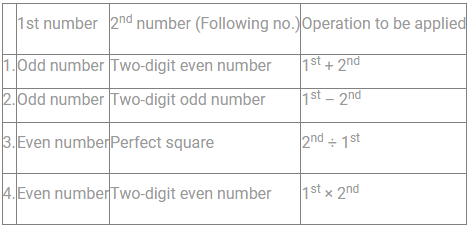

(i) In first row 6 is an even number and 36 is a perfect square so apply condition 3
→ 36 ÷ 6 = 6
Now 6 is an even no. and next 36 is a perfect square so apply condition 3
→ 36 ÷ 6 = 6
Now 6 is an even no. and next 12 is a two digit even number so apply condition 4
→ 6 × 12 = 72 and 72 is the resultant of 1st row.
(ii) In 2nd row 15 is an odd no. and 11 is a two digit odd no. so condition 2 is applied
→ 17 – 13 = 4
Now 4 is an even number and next 12 is a two digit even no. so apply condition 4
→ 4 × 12 = 48
Now 48 is an even number and 144 is a perfect square so apply condition 3
→ 144 ÷ 48 = 3 and 3 is the resultant of the second row
Now difference of resultant of 1st and 2nd row = 72 – 3 = 69
Hence, the correct option is (C).
Analyse the information given below in each question and answer the questions that followI. Regulatory authorities have not released any clear guidelines on how exactly to deal with payments of Indian exporters due from Russian entities.II. As of now, banks are themselves taking precautions in dealing with entities on the sanctions list of the US, the EU and the United Nations.III. Discussions on alternative payment mechanisms are also ongoing.Of the three statements given above, some can be facts and some can be inferences based on those facts. Which of these can be called as an ‘Inference’?- a)Only I
- b)Only II
- c)Only III
- d)Both II and III
- e)All I, II and III
Correct answer is option 'C'. Can you explain this answer?
Analyse the information given below in each question and answer the questions that follow
I. Regulatory authorities have not released any clear guidelines on how exactly to deal with payments of Indian exporters due from Russian entities.
II. As of now, banks are themselves taking precautions in dealing with entities on the sanctions list of the US, the EU and the United Nations.
III. Discussions on alternative payment mechanisms are also ongoing.
Of the three statements given above, some can be facts and some can be inferences based on those facts. Which of these can be called as an ‘Inference’?
a)
Only I
b)
Only II
c)
Only III
d)
Both II and III
e)
All I, II and III
|
|
Rohan Sengupta answered |
The first statement says that clear guidelines have not yet been issued which indirectly means that it is under process.
When we look at III, it says that discussions are still going on and this is what we can infer. As; if the clear instructions aren’t yet released then they are definitely being worked upon and must be in the pipeline.
So, the best is to mark option (c) as the answer.
Directions: Study the following information to answer these questions.A is the sister of S and T. J is the only son of the brother-in-law of S. S is married to M. S is son of K. K and B has three child. A is married to Q. R is son of S.T is unmarried. B is the grandmother of R.How R and J are related to each other.- a)Brother
- b)Sister
- c)Cousins
- d)None of these
- e)Cannot be determined
Correct answer is option 'C'. Can you explain this answer?
Directions: Study the following information to answer these questions.
A is the sister of S and T. J is the only son of the brother-in-law of S. S is married to M. S is son of K. K and B has three child. A is married to Q. R is son of S.T is unmarried. B is the grandmother of R.
How R and J are related to each other.
a)
Brother
b)
Sister
c)
Cousins
d)
None of these
e)
Cannot be determined
|
|
Kabir Verma answered |
From the given Information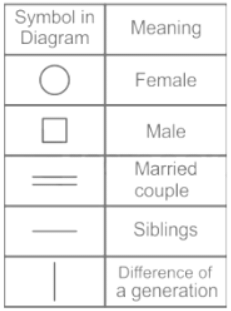
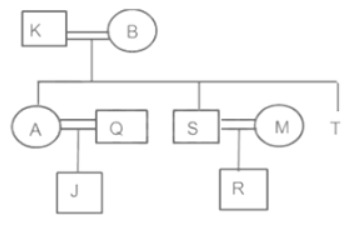

Based on the given information we can draw family tree:

Hence J and R are cousins.
Direction: In the following question, some part of the sentence may have an error. Find out which part of the sentence has an error and select the appropriate option. If a sentence is free from errors, select option 'No error'.Q. We agreed to get /(A) together sooner than later /(B) and I’m looking forward /(C) to work with him. /(D) No error /(E)- a)A
- b)B
- c)C
- d)D
- e)E
Correct answer is option 'D'. Can you explain this answer?
Direction: In the following question, some part of the sentence may have an error. Find out which part of the sentence has an error and select the appropriate option. If a sentence is free from errors, select option 'No error'.
Q. We agreed to get /(A) together sooner than later /(B) and I’m looking forward /(C) to work with him. /(D) No error /(E)
a)
A
b)
B
c)
C
d)
D
e)
E

|
Prashanth Choudhary answered |
Error Analysis:
The error in the given sentence is in part (C). The correct preposition to be used after "looking forward" is "to" instead of "to work". The correct sentence should be "I'm looking forward to working with him."
Corrected Sentence:
We agreed to get together sooner than later and I'm looking forward to working with him.
Explanation:
The given sentence is a compound sentence that expresses two ideas: agreeing to get together and looking forward to working with someone. Let's analyze each part of the sentence:
(A) "We agreed to get together sooner than later" - This part of the sentence is grammatically correct and does not contain any errors. It states that the speaker and someone else agreed to meet or spend time together in the near future.
(B) "and I'm looking forward" - This part of the sentence is also grammatically correct. The phrase "looking forward" indicates anticipation or excitement about something.
(C) "to work with him" - This is the part of the sentence that contains the error. After the phrase "looking forward," the correct preposition to be used is "to" followed by a gerund (verb + -ing form). Therefore, the correct phrase should be "looking forward to working with him." This means the speaker is excited or eager to work together with the person mentioned.
(D) "No error" - This option is incorrect as we have identified an error in part (C) of the sentence.
(E) "No error" - This option is incorrect as we have identified an error in part (C) of the sentence.
Therefore, the correct answer is option (C), and the sentence should be corrected as "We agreed to get together sooner than later and I'm looking forward to working with him."
The error in the given sentence is in part (C). The correct preposition to be used after "looking forward" is "to" instead of "to work". The correct sentence should be "I'm looking forward to working with him."
Corrected Sentence:
We agreed to get together sooner than later and I'm looking forward to working with him.
Explanation:
The given sentence is a compound sentence that expresses two ideas: agreeing to get together and looking forward to working with someone. Let's analyze each part of the sentence:
(A) "We agreed to get together sooner than later" - This part of the sentence is grammatically correct and does not contain any errors. It states that the speaker and someone else agreed to meet or spend time together in the near future.
(B) "and I'm looking forward" - This part of the sentence is also grammatically correct. The phrase "looking forward" indicates anticipation or excitement about something.
(C) "to work with him" - This is the part of the sentence that contains the error. After the phrase "looking forward," the correct preposition to be used is "to" followed by a gerund (verb + -ing form). Therefore, the correct phrase should be "looking forward to working with him." This means the speaker is excited or eager to work together with the person mentioned.
(D) "No error" - This option is incorrect as we have identified an error in part (C) of the sentence.
(E) "No error" - This option is incorrect as we have identified an error in part (C) of the sentence.
Therefore, the correct answer is option (C), and the sentence should be corrected as "We agreed to get together sooner than later and I'm looking forward to working with him."
Direction: Fill in the blanks with appropriate words.Prior to 1991, India’s economy and financial system were heavily regulated and ____(1)___ by the public sector. A complicated regulatory regime required firms to obtain licenses for most economic activities, and many industries were ____(2)____ for the public sector, including much of the financial system. Bank nationalizations in 1969 and 1980 increased the public sector share of deposits 5 to over 80 per cent, and further branch licensing was rigidly controlled. Primarily focused on financing government ____(3)____ and serving government priority sectors such as agriculture, India’s public banks lacked proper lending ____(4)____ and exhibited a high number of non-performing loans. Following a balance of payments crisis in 1991, however, a number of structural ___(5)___ were implemented that greatly deregulated many economic ____(6)____, and in November 1991, a broad financial reform agenda was established in India by the Committee on the Financial System (CFS). The CFS was appointed by the Government of India to examine the ____(7)____ financial system and make recommendations for improving its efficiency so as to more effectively meet the credit needs of ____(8)____. One of the committee’s recommendations to meet this goal was to introduce greater competition into the banking system by ____(9)____ more foreign banks to enter India. It was argued that the entry of additional foreign banks would improve the competitive efficiency of the Indian banking system and induce an ____(10)____ of banking technology.What should come in the place of blank (7)?- a)Inaction
- b)Cease
- c)Destroyed
- d)Existing
- e)Inert
Correct answer is option 'D'. Can you explain this answer?
Direction: Fill in the blanks with appropriate words.
Prior to 1991, India’s economy and financial system were heavily regulated and ____(1)___ by the public sector. A complicated regulatory regime required firms to obtain licenses for most economic activities, and many industries were ____(2)____ for the public sector, including much of the financial system. Bank nationalizations in 1969 and 1980 increased the public sector share of deposits 5 to over 80 per cent, and further branch licensing was rigidly controlled. Primarily focused on financing government ____(3)____ and serving government priority sectors such as agriculture, India’s public banks lacked proper lending ____(4)____ and exhibited a high number of non-performing loans. Following a balance of payments crisis in 1991, however, a number of structural ___(5)___ were implemented that greatly deregulated many economic ____(6)____, and in November 1991, a broad financial reform agenda was established in India by the Committee on the Financial System (CFS). The CFS was appointed by the Government of India to examine the ____(7)____ financial system and make recommendations for improving its efficiency so as to more effectively meet the credit needs of ____(8)____. One of the committee’s recommendations to meet this goal was to introduce greater competition into the banking system by ____(9)____ more foreign banks to enter India. It was argued that the entry of additional foreign banks would improve the competitive efficiency of the Indian banking system and induce an ____(10)____ of banking technology.
What should come in the place of blank (7)?
a)
Inaction
b)
Cease
c)
Destroyed
d)
Existing
e)
Inert
|
|
Kabir Verma answered |
The passage is about 'Indian economy before 1991'.
Let us refer to this line from the passage, "The CFS was appointed by the Government of India to examine the ____(7)____ financial system and make recommendations".
From the above sentence, we get to know that CFS established a broad financial reform that examined the current financial system to make changes.
In option (D), 'Existing' means in existence or operation at the current time.
So, 'Existing' is the correct word for blank (7).
When more than one bank is allowing credit facilities to one party in coordination with each other under a formal arrangement, the arrangement is generally known as:- a)Participation
- b)Consortium
- c)Syndication
- d)Multiple Banking
- e)None of these
Correct answer is option 'B'. Can you explain this answer?
When more than one bank is allowing credit facilities to one party in coordination with each other under a formal arrangement, the arrangement is generally known as:
a)
Participation
b)
Consortium
c)
Syndication
d)
Multiple Banking
e)
None of these

|
Raj Mehta answered |
Explanation:
Consortium refers to a formal arrangement where more than one bank provides credit facilities to a single party in coordination with each other. It is a common practice in the banking industry, especially for large-scale projects that require substantial funding.
Here is a detailed explanation of why the correct answer is option 'B' - Consortium:
1. Participation: Participation generally refers to a situation where a bank buys a portion of a loan from another bank that originally extended the credit facility. It involves the transfer of risk and benefits of the loan to the participating bank. However, it does not necessarily involve coordination and joint lending among multiple banks.
2. Syndication: Syndication is a process where a group of banks comes together to provide a loan to a borrower. However, in syndication, each bank has a separate agreement with the borrower and holds a distinct portion of the loan. The banks cooperate in the loan process but do not have a formal arrangement to coordinate their lending activities.
3. Multiple Banking: Multiple banking refers to a situation where a borrower maintains multiple banking relationships and obtains credit facilities from different banks. However, in multiple banking, there is no formal arrangement or coordination among the banks. Each bank operates independently and assesses the borrower's creditworthiness on its own.
4. Consortium: Consortium, on the other hand, involves a formal arrangement among multiple banks to jointly provide credit facilities to a single party. The banks work together as a group and coordinate their lending activities. They share the risk, benefits, and decision-making process related to the credit facility. This arrangement allows the borrower to access a larger amount of funds than what a single bank can provide. Consortium lending is commonly used for large-scale projects such as infrastructure development, real estate projects, and corporate financing.
In conclusion, the term used for a formal arrangement where multiple banks provide credit facilities to a single party in coordination with each other is a Consortium. This arrangement allows banks to pool their resources and expertise to provide larger credit facilities and manage the associated risks effectively.
Consortium refers to a formal arrangement where more than one bank provides credit facilities to a single party in coordination with each other. It is a common practice in the banking industry, especially for large-scale projects that require substantial funding.
Here is a detailed explanation of why the correct answer is option 'B' - Consortium:
1. Participation: Participation generally refers to a situation where a bank buys a portion of a loan from another bank that originally extended the credit facility. It involves the transfer of risk and benefits of the loan to the participating bank. However, it does not necessarily involve coordination and joint lending among multiple banks.
2. Syndication: Syndication is a process where a group of banks comes together to provide a loan to a borrower. However, in syndication, each bank has a separate agreement with the borrower and holds a distinct portion of the loan. The banks cooperate in the loan process but do not have a formal arrangement to coordinate their lending activities.
3. Multiple Banking: Multiple banking refers to a situation where a borrower maintains multiple banking relationships and obtains credit facilities from different banks. However, in multiple banking, there is no formal arrangement or coordination among the banks. Each bank operates independently and assesses the borrower's creditworthiness on its own.
4. Consortium: Consortium, on the other hand, involves a formal arrangement among multiple banks to jointly provide credit facilities to a single party. The banks work together as a group and coordinate their lending activities. They share the risk, benefits, and decision-making process related to the credit facility. This arrangement allows the borrower to access a larger amount of funds than what a single bank can provide. Consortium lending is commonly used for large-scale projects such as infrastructure development, real estate projects, and corporate financing.
In conclusion, the term used for a formal arrangement where multiple banks provide credit facilities to a single party in coordination with each other is a Consortium. This arrangement allows banks to pool their resources and expertise to provide larger credit facilities and manage the associated risks effectively.
Direction: To complete a certain work, C working alone takes twice as long as A and B working together. A working alone takes 3 times as long as B and C working together. All the three together can complete the work in 5 days.Q. Efficiency of A become twice of the efficiency, A had earlier. Now A and C started the work together but C left after sometime and A finished the remaining work in 5 days. Find out, after how many days from the start did C leave?- a)3
- b)5
- c)6
- d)8
- e)10
Correct answer is option 'A'. Can you explain this answer?
Direction: To complete a certain work, C working alone takes twice as long as A and B working together. A working alone takes 3 times as long as B and C working together. All the three together can complete the work in 5 days.
Q. Efficiency of A become twice of the efficiency, A had earlier. Now A and C started the work together but C left after sometime and A finished the remaining work in 5 days. Find out, after how many days from the start did C leave?
a)
3
b)
5
c)
6
d)
8
e)
10

|
Bibek Dasgupta answered |
To solve this problem, let's first assign variables to the rates at which A, B, and C can complete the work.
Let:
- The rate at which A can complete the work be "a" (in units of work per day),
- The rate at which B can complete the work be "b" (in units of work per day), and
- The rate at which C can complete the work be "c" (in units of work per day).
Given information:
1. C working alone takes twice as long as A and B working together.
- This means that the ratio of their rates is 1:2, or a:b = 1:2.
- Therefore, C's rate can be expressed as c = 2a + 2b.
2. A working alone takes 3 times as long as B and C working together.
- This means that the ratio of their rates is 3:1, or a:c = 3:1.
- From the previous equation (c = 2a + 2b), we can substitute c with (2a + 2b) in the ratio, giving a:(2a + 2b) = 3:1.
- Simplifying this ratio gives a:b = 3:4.
3. All three together can complete the work in 5 days.
- This means that their combined rate is 1/5 of the work per day, or a + b + c = 1/5.
Now, let's solve the system of equations to find the values of a, b, and c.
Equation 1: a:b = 3:4
- We can choose any convenient values for a and b that satisfy this ratio.
- Let's assume a = 3 and b = 4.
- Therefore, a:b = 3:4.
Equation 2: c = 2a + 2b
- Substituting the assumed values of a and b, we get c = 2(3) + 2(4) = 6 + 8 = 14.
Equation 3: a + b + c = 1/5
- Substituting the values of a, b, and c, we get 3 + 4 + 14 = 1/5.
- Simplifying this equation gives 21 + 14 = 1/5.
- Therefore, 35 = 1/5, or 35/5 = 1.
- Hence, the equation is satisfied.
Now, let's consider the second scenario where A's efficiency becomes twice what it was earlier.
New values:
- Let A's new rate be "a'".
- Since A's new efficiency is twice what it was earlier, a' = 2a.
A and C started the work together, but C left after some time, and A finished the remaining work in 5 days.
Let's assume that C left after "x" days from the start.
Key points:
- In "x" days, A and C working together can complete (a' + c)x units of work.
- In the remaining 5 - x days, A working alone can complete a'(5 - x) units of work.
- The total work completed is equal to 1 (the entire work
Let:
- The rate at which A can complete the work be "a" (in units of work per day),
- The rate at which B can complete the work be "b" (in units of work per day), and
- The rate at which C can complete the work be "c" (in units of work per day).
Given information:
1. C working alone takes twice as long as A and B working together.
- This means that the ratio of their rates is 1:2, or a:b = 1:2.
- Therefore, C's rate can be expressed as c = 2a + 2b.
2. A working alone takes 3 times as long as B and C working together.
- This means that the ratio of their rates is 3:1, or a:c = 3:1.
- From the previous equation (c = 2a + 2b), we can substitute c with (2a + 2b) in the ratio, giving a:(2a + 2b) = 3:1.
- Simplifying this ratio gives a:b = 3:4.
3. All three together can complete the work in 5 days.
- This means that their combined rate is 1/5 of the work per day, or a + b + c = 1/5.
Now, let's solve the system of equations to find the values of a, b, and c.
Equation 1: a:b = 3:4
- We can choose any convenient values for a and b that satisfy this ratio.
- Let's assume a = 3 and b = 4.
- Therefore, a:b = 3:4.
Equation 2: c = 2a + 2b
- Substituting the assumed values of a and b, we get c = 2(3) + 2(4) = 6 + 8 = 14.
Equation 3: a + b + c = 1/5
- Substituting the values of a, b, and c, we get 3 + 4 + 14 = 1/5.
- Simplifying this equation gives 21 + 14 = 1/5.
- Therefore, 35 = 1/5, or 35/5 = 1.
- Hence, the equation is satisfied.
Now, let's consider the second scenario where A's efficiency becomes twice what it was earlier.
New values:
- Let A's new rate be "a'".
- Since A's new efficiency is twice what it was earlier, a' = 2a.
A and C started the work together, but C left after some time, and A finished the remaining work in 5 days.
Let's assume that C left after "x" days from the start.
Key points:
- In "x" days, A and C working together can complete (a' + c)x units of work.
- In the remaining 5 - x days, A working alone can complete a'(5 - x) units of work.
- The total work completed is equal to 1 (the entire work
LBS is one of the economic measures taken by central government for Financial Inclusion. What does LBS Stands for?- a)Loan Banking Scheme
- b)Lead Banking Scheme
- c)Liquidity Banking Scheme
- d)Liability Banking scheme
- e)None of these
Correct answer is option 'B'. Can you explain this answer?
LBS is one of the economic measures taken by central government for Financial Inclusion. What does LBS Stands for?
a)
Loan Banking Scheme
b)
Lead Banking Scheme
c)
Liquidity Banking Scheme
d)
Liability Banking scheme
e)
None of these
|
|
Rohan Sengupta answered |
Lead Banking Scheme provides the prime/lead role to an individual Bank.
Banks that come under the Lead Banking Scheme should be either Private or Public Banks.
This Lead Bank acts as a credit Institution in its allotted district.
It will help to promote small-scale industries, the Agriculture sector, and other economic services.
Hence, the correct option is (B).
Direction: Study the information given below and answer the questions based on it.# means either hour hand or minute hand is at 9$ means either hour hand or minute hand is at 2@ means either hour hand or minute hand is at 3& means either hour hand or minute hand is at 5% mean either hour hand or minute hand is at 12+ means either hour hand or minute hand is at 8Note: If two symbols are given then by default first symbol is considered as hour hand and second one is considered as minute hand . And all time are considered at AM.For eg. #@ ⟶9:15 amQ. Train is scheduled to start at ‘$ @’. A passenger reaches the station 25 minutes after the departure of the train. At what time does the passenger reach the station?- a)+%
- b)$+
- c)# @
- d)&%
- e)@ $
Correct answer is option 'B'. Can you explain this answer?
Direction: Study the information given below and answer the questions based on it.
# means either hour hand or minute hand is at 9
$ means either hour hand or minute hand is at 2
@ means either hour hand or minute hand is at 3
& means either hour hand or minute hand is at 5
% mean either hour hand or minute hand is at 12
+ means either hour hand or minute hand is at 8
Note: If two symbols are given then by default first symbol is considered as hour hand and second one is considered as minute hand . And all time are considered at AM.
For eg. #@ ⟶9:15 am
Q. Train is scheduled to start at ‘$ @’. A passenger reaches the station 25 minutes after the departure of the train. At what time does the passenger reach the station?
a)
+%
b)
$+
c)
# @
d)
&%
e)
@ $

|
Nitin Mehra answered |
Explanation:
The train is scheduled to start at '$ @' which means the time is 2:15 am.
The passenger reaches the station 25 minutes after the departure of the train.
Calculating the time of passenger's arrival:
- The train departs at 2:15 am
- 25 minutes after the departure is 2:15 am + 25 minutes = 2:40 am
Therefore, the passenger reaches the station at 2:40 am, which is represented as '$+'.
Hence, the correct answer is option 'B' ($+).
The train is scheduled to start at '$ @' which means the time is 2:15 am.
The passenger reaches the station 25 minutes after the departure of the train.
Calculating the time of passenger's arrival:
- The train departs at 2:15 am
- 25 minutes after the departure is 2:15 am + 25 minutes = 2:40 am
Therefore, the passenger reaches the station at 2:40 am, which is represented as '$+'.
Hence, the correct answer is option 'B' ($+).
The passage given below carries information based on which questions have been framed. You must read the given information carefully and answer the questions that follow:The Uttar Pradesh government is building the first handicrafts park in Sector 29 of Yamuna Expressway Industrial Development Authority (YEIDA). The factories being set up at the park will provide permanent employment to 22,144 people. According to the government, a total of 76 industrialists have acquired land at the park spread over an area of 50 acres to set up their factories at the cost of Rs 403 crore.The laden handicrafts park of UP will feature workshops, factories and outlets making, showcasing and selling the wide ranging handicrafts of the state to the domestic and global visitors, aiming at conserving the traditional crafts, providing employment to thousands of artisans of the state and boosting the handicrafts sector's contribution to the state's economy. UP's rich traditional handicrafts include Banarasi sarees, brass works of Moradabad, perfumes of Kannauj, Chikankari of Lucknow and Terracotta Art of Gorakhpur that have achieved global recognition.Every district of the state has at least one special product that is integral to its identity. The park will showcase their craftsmanship to the world and also enable people to get all famous handicrafts of UP under the same roof. It will also provide a huge market for these products, boosting UP's handicrafts business. People living in Delhi and Noida will also have easy access to the handicrafts of Lucknow, Meerut, Bareilly, Firozabad, Agra, Varanasi, Chandauli, Gorakhpur, Allahabad, Pratapgarh, Azamgarh, Mirzapur and Jhansi and Lalitpur.Prominent among the 76 investors at the park include Vikas Exports, which deals in wood, metal and marble works. Vikas Exports has been allotted 5,000 square metres of land to set up its venture. Similarly, land has been allotted to The Silk Factory, Rateria Exports, Narayan Creation, Wazir Chand & Co, Dux India Industries Pvt Ltd, Dawar Footwear Industries and Specialist Home Concepts. The park is located near the upcoming Jewar airport which will facilitate exports. It is noteworthy that the Yogi government's schemes like ODOP as well as Vishwakarma Shram Samman, seek to promote both local artisans and local handicrafts and artworks. The Matikala Board, formed on the initiative of Chief Minister Yogi Adityanath, seeks to protect and promote local artisans. The artisans are provided training and market facilities as part of the initiativeQ. How will the park facilitate exports from the region?- a)The park will showcase their craftsmanship to the world
- b)People living in Delhi and Noida will also have easy access to the handicrafts
- c)The park will showcase UP’s rich tradition which will make the products more acceptable in the global markets
- d)Every district of the state has at least one special product that is integral to its identity.
- e)The park is located near the upcoming Jewar airport which will facilitate exports.
Correct answer is option 'E'. Can you explain this answer?
The passage given below carries information based on which questions have been framed. You must read the given information carefully and answer the questions that follow:
The Uttar Pradesh government is building the first handicrafts park in Sector 29 of Yamuna Expressway Industrial Development Authority (YEIDA). The factories being set up at the park will provide permanent employment to 22,144 people. According to the government, a total of 76 industrialists have acquired land at the park spread over an area of 50 acres to set up their factories at the cost of Rs 403 crore.
The laden handicrafts park of UP will feature workshops, factories and outlets making, showcasing and selling the wide ranging handicrafts of the state to the domestic and global visitors, aiming at conserving the traditional crafts, providing employment to thousands of artisans of the state and boosting the handicrafts sector's contribution to the state's economy. UP's rich traditional handicrafts include Banarasi sarees, brass works of Moradabad, perfumes of Kannauj, Chikankari of Lucknow and Terracotta Art of Gorakhpur that have achieved global recognition.
Every district of the state has at least one special product that is integral to its identity. The park will showcase their craftsmanship to the world and also enable people to get all famous handicrafts of UP under the same roof. It will also provide a huge market for these products, boosting UP's handicrafts business. People living in Delhi and Noida will also have easy access to the handicrafts of Lucknow, Meerut, Bareilly, Firozabad, Agra, Varanasi, Chandauli, Gorakhpur, Allahabad, Pratapgarh, Azamgarh, Mirzapur and Jhansi and Lalitpur.
Prominent among the 76 investors at the park include Vikas Exports, which deals in wood, metal and marble works. Vikas Exports has been allotted 5,000 square metres of land to set up its venture. Similarly, land has been allotted to The Silk Factory, Rateria Exports, Narayan Creation, Wazir Chand & Co, Dux India Industries Pvt Ltd, Dawar Footwear Industries and Specialist Home Concepts. The park is located near the upcoming Jewar airport which will facilitate exports. It is noteworthy that the Yogi government's schemes like ODOP as well as Vishwakarma Shram Samman, seek to promote both local artisans and local handicrafts and artworks. The Matikala Board, formed on the initiative of Chief Minister Yogi Adityanath, seeks to protect and promote local artisans. The artisans are provided training and market facilities as part of the initiative
Q. How will the park facilitate exports from the region?
a)
The park will showcase their craftsmanship to the world
b)
People living in Delhi and Noida will also have easy access to the handicrafts
c)
The park will showcase UP’s rich tradition which will make the products more acceptable in the global markets
d)
Every district of the state has at least one special product that is integral to its identity.
e)
The park is located near the upcoming Jewar airport which will facilitate exports.

|
Aditya Ghoshal answered |
Facilitation of Exports at the Handicrafts Park:
The park will facilitate exports from the region through various means:
- Strategic Location: The park is located near the upcoming Jewar airport, which will provide easy access for transportation of goods to international markets.
- Showcasing Craftsmanship: By showcasing the rich traditional handicrafts of Uttar Pradesh, the park will attract global visitors and create demand for these products in international markets.
- Access to Major Markets: People living in major cities like Delhi and Noida will have easy access to the handicrafts produced at the park, making it convenient for exports to these markets.
- Promotion of Local Artisans: The park, through schemes like ODOP and Vishwakarma Shram Samman, aims to promote local artisans and their handicrafts, making them more competitive in the global market.
- Market Facilities: The park will provide market facilities for local artisans, enabling them to showcase their products to a wider audience and attract international buyers.
In conclusion, the handicrafts park in Sector 29 of Yamuna Expressway Industrial Development Authority will play a crucial role in facilitating exports from the region by leveraging its strategic location, promoting local craftsmanship, and providing market access to major cities and international markets.
The park will facilitate exports from the region through various means:
- Strategic Location: The park is located near the upcoming Jewar airport, which will provide easy access for transportation of goods to international markets.
- Showcasing Craftsmanship: By showcasing the rich traditional handicrafts of Uttar Pradesh, the park will attract global visitors and create demand for these products in international markets.
- Access to Major Markets: People living in major cities like Delhi and Noida will have easy access to the handicrafts produced at the park, making it convenient for exports to these markets.
- Promotion of Local Artisans: The park, through schemes like ODOP and Vishwakarma Shram Samman, aims to promote local artisans and their handicrafts, making them more competitive in the global market.
- Market Facilities: The park will provide market facilities for local artisans, enabling them to showcase their products to a wider audience and attract international buyers.
In conclusion, the handicrafts park in Sector 29 of Yamuna Expressway Industrial Development Authority will play a crucial role in facilitating exports from the region by leveraging its strategic location, promoting local craftsmanship, and providing market access to major cities and international markets.
How many meaningful English words can be formed, starting with S, with the second, the fourth, the fifth and the eighth letters of the word PERISHED, using each letter only once in each word? (To be counted from left)- a)None
- b)One
- c)Two
- d)Three
- e)More than three
Correct answer is option 'B'. Can you explain this answer?
How many meaningful English words can be formed, starting with S, with the second, the fourth, the fifth and the eighth letters of the word PERISHED, using each letter only once in each word? (To be counted from left)
a)
None
b)
One
c)
Two
d)
Three
e)
More than three
|
|
Kabir Verma answered |
Word: PERISHED
2nd letter = E; 4th letter = I; 5th letter = S; 8th letter = D
Letters given: EISD
Words possible starting with S: SIDE
Hence, only 1 such word is possible.
Directions: Study the following information carefully and answer the given questions given below:Eight persons P, Q, R, S, A, B, C, and D are sitting around a circular table but not necessarily in the same order. There is also a bigger circle circumscribing the smaller circle. Four persons are sitting in the smaller circle and remaining four persons are sitting in the bigger circle, facing each other. Persons sitting in the smaller circle are facing away from the centre and persons sitting in the bigger circle are facing towards the centre of the circle. The number of assignments they have to submit is different and are multiple of 3 viz, 3, 6, 9, 12, 15,18, 21, and 24. Q is sitting in the smaller circle, third to the left of C, and have to submit 6 assignments. A sit second to the left of P, and have to submit five times more submit than P. Number of assignments A and B have to submit together is three more than to the number of assignments submitted by S. S faces the person who is an immediate neighbor of C, but not the one who have submitted less than 10 assignments. B and P are immediate neighbor of each other. D faces the person who have to submit three more assignments than D. R has to submit half number of assignments than C. The person who sits on the immediate right of B have to submit the number of assignments which is square root of the number of assignments B has to submit.Q. What is the product of the number of assignments submitted by D and B together?- a)108
- b)216
- c)162
- d)72
- e)110
Correct answer is option 'C'. Can you explain this answer?
Directions: Study the following information carefully and answer the given questions given below:
Eight persons P, Q, R, S, A, B, C, and D are sitting around a circular table but not necessarily in the same order. There is also a bigger circle circumscribing the smaller circle. Four persons are sitting in the smaller circle and remaining four persons are sitting in the bigger circle, facing each other. Persons sitting in the smaller circle are facing away from the centre and persons sitting in the bigger circle are facing towards the centre of the circle. The number of assignments they have to submit is different and are multiple of 3 viz, 3, 6, 9, 12, 15,18, 21, and 24. Q is sitting in the smaller circle, third to the left of C, and have to submit 6 assignments. A sit second to the left of P, and have to submit five times more submit than P. Number of assignments A and B have to submit together is three more than to the number of assignments submitted by S. S faces the person who is an immediate neighbor of C, but not the one who have submitted less than 10 assignments. B and P are immediate neighbor of each other. D faces the person who have to submit three more assignments than D. R has to submit half number of assignments than C. The person who sits on the immediate right of B have to submit the number of assignments which is square root of the number of assignments B has to submit.
Q. What is the product of the number of assignments submitted by D and B together?
a)
108
b)
216
c)
162
d)
72
e)
110
|
|
Rohan Sengupta answered |
Eight persons: P, Q, R, S, A, B, C, and D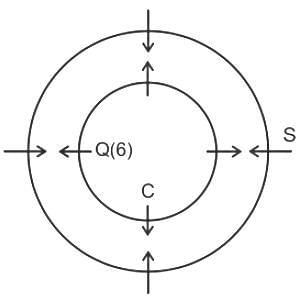
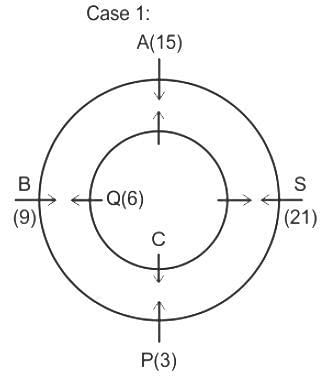
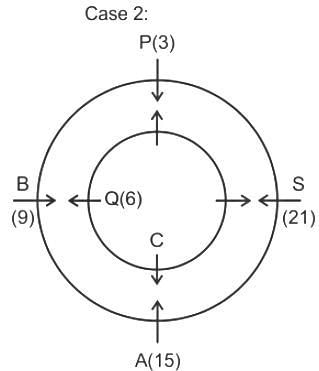
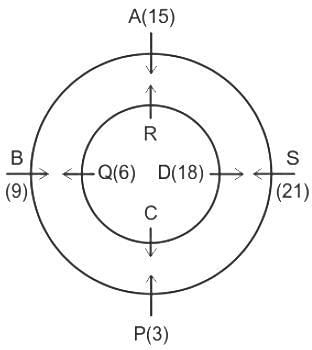
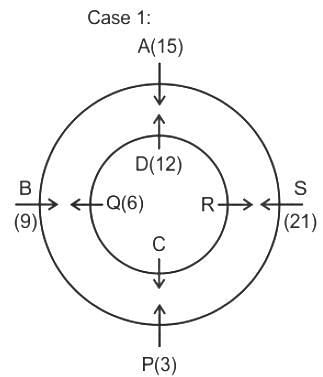
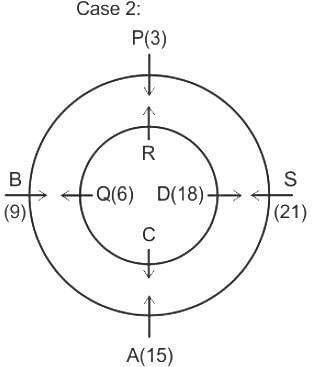
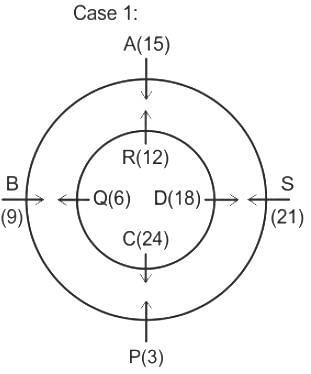
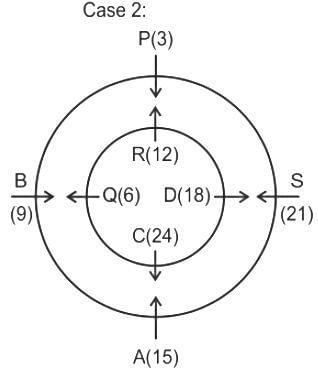
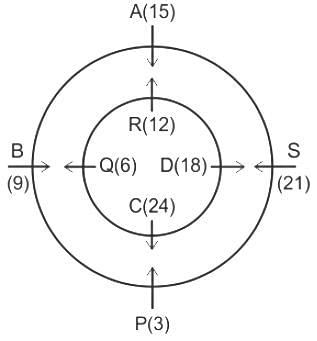
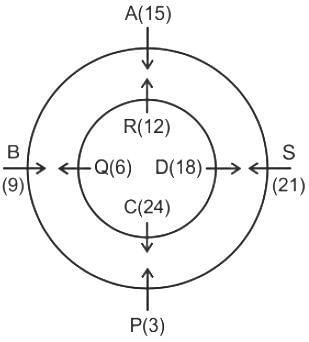
Number of assignments: 3, 6, 9, 12, 15, 18, 21, and 24.
1. Q is sitting in the smaller circle, third to the left of C, and have to submit 6 assignments.
2. S faces the person who is an immediate neighbor of C, but not the one who have submitted less than 10 assignments.
On combining these two lines we get, that S faces the person who sit on the immediate left of C.

3. A sit second to the left of P, and have to submit five times more submit than P.
4. B and P are immediate neighbor of each other.
5. Number of assignments A and B have to submit together is three more than to the number of assignments submitted by S.
On combining these three sentences we get,
A and P both sit on the bigger circle as no space left for them to sit in the smaller circle and also we have two cases for the position of P.
A will submit 15 assignments and P will submit 3 assignments.
A will submit 15 assignments and B will submit 9 assignments and the total of their assignments are 24.
According to this the number of assignments submitted by S is 21.
Now we have two cases for the position of P.
First Case: When P sits on the immediate right of B.

Second Case: When P sits on the immediate left of B.

6. D faces the person who have to submit three more assignments than D.
From this line we have three possibilities for the position of D.
First Case: When D faces S.
In this case D will submit 18 assignments.

First Case (a): When D faces A.
In this case D will submit 12 assignments.

Second Case: When D faces S and submit 18 assignments.

7. R has to submit half number of assignments than C.
From this sentence it is clear that R will submit 12 assignments and C will submit 24 assignments.
So, our First case (a) is eliminated.
From this it is now clear that D will submit 18 assignments.
First Case:

Second Possibility:

8. The person who sits on the immediate right of B have to submit the number of assignments which is square root of the number of assignments B has to submit.
From this sentence our Second case is eliminated, as in that A sit to the immediate right of B, and submitting 12 assignments which is not possible as 12 is not the square root of 9.

The final arrangement:

Number of assignments submitted by D = 18.
Number of assignments submitted by B = 9.
Product = 18 × 9 = 162
So, 162 is the product of the number of the assignments submitted by D and B together.
Hence, the correct option is (C).
Ram has 5 daughters. The average age of the 5 sisters is 28 years. The youngest one is 16 years old. What was the average age of the 4 sisters before the youngest one was born?- a)28 years
- b)15 years
- c)31 years
- d)16 years
- e)20 years
Correct answer is option 'B'. Can you explain this answer?
Ram has 5 daughters. The average age of the 5 sisters is 28 years. The youngest one is 16 years old. What was the average age of the 4 sisters before the youngest one was born?
a)
28 years
b)
15 years
c)
31 years
d)
16 years
e)
20 years

|
Jyoti Sarkar answered |
Calculation of the average age of 4 sisters before the youngest one was born:
1. Given Information:
- Ram has 5 daughters.
- The average age of the 5 sisters is 28 years.
- The youngest daughter is 16 years old.
2. Calculate the sum of the ages of all 5 daughters:
- Total age of 5 sisters = 5 * 28 = 140 years
3. Subtract the age of the youngest daughter:
- Sum of the ages of the 4 older sisters = 140 - 16 = 124 years
4. Calculate the average age of the 4 older sisters:
- Average age of 4 sisters = 124 / 4 = 31 years
5. Conclusion:
- The average age of the 4 sisters before the youngest one was born was 31 years.
Therefore, the correct answer is option B) 15 years.
1. Given Information:
- Ram has 5 daughters.
- The average age of the 5 sisters is 28 years.
- The youngest daughter is 16 years old.
2. Calculate the sum of the ages of all 5 daughters:
- Total age of 5 sisters = 5 * 28 = 140 years
3. Subtract the age of the youngest daughter:
- Sum of the ages of the 4 older sisters = 140 - 16 = 124 years
4. Calculate the average age of the 4 older sisters:
- Average age of 4 sisters = 124 / 4 = 31 years
5. Conclusion:
- The average age of the 4 sisters before the youngest one was born was 31 years.
Therefore, the correct answer is option B) 15 years.
There is a 30% increase in the price of an article in the first year, a 20% decrease in the second year and a 10% increase in the next year. If the present price of the article is Rs.2288, then what was the price 3 years ago?- a)Rs.1500
- b)Rs.2000
- c)Rs.1800
- d)Rs.1600
- e)Rs.2400
Correct answer is option 'B'. Can you explain this answer?
There is a 30% increase in the price of an article in the first year, a 20% decrease in the second year and a 10% increase in the next year. If the present price of the article is Rs.2288, then what was the price 3 years ago?
a)
Rs.1500
b)
Rs.2000
c)
Rs.1800
d)
Rs.1600
e)
Rs.2400

|
Arindam Roy answered |
Given:
- 30% increase in the price of an article in the first year
- 20% decrease in the second year
- 10% increase in the next year
- Present price of the article is Rs. 2288
To find:
- The price of the article 3 years ago
Solution:
Let's assume the price of the article 3 years ago was x.
Year 1:
- 30% increase in the price of the article
- New price = x + (30/100)x = x + 0.3x = 1.3x
Year 2:
- 20% decrease in the price of the article
- New price = 1.3x - (20/100)(1.3x) = 1.3x - 0.26x = 1.04x
Year 3:
- 10% increase in the price of the article
- New price = 1.04x + (10/100)(1.04x) = 1.04x + 0.104x = 1.144x
Given that the present price of the article is Rs. 2288, we can equate it to the price after 3 years:
1.144x = 2288
Dividing both sides by 1.144:
x = 2288 / 1.144
x = 2000
Therefore, the price of the article 3 years ago was Rs. 2000.
Hence, the correct answer is option 'B' (Rs. 2000).
- 30% increase in the price of an article in the first year
- 20% decrease in the second year
- 10% increase in the next year
- Present price of the article is Rs. 2288
To find:
- The price of the article 3 years ago
Solution:
Let's assume the price of the article 3 years ago was x.
Year 1:
- 30% increase in the price of the article
- New price = x + (30/100)x = x + 0.3x = 1.3x
Year 2:
- 20% decrease in the price of the article
- New price = 1.3x - (20/100)(1.3x) = 1.3x - 0.26x = 1.04x
Year 3:
- 10% increase in the price of the article
- New price = 1.04x + (10/100)(1.04x) = 1.04x + 0.104x = 1.144x
Given that the present price of the article is Rs. 2288, we can equate it to the price after 3 years:
1.144x = 2288
Dividing both sides by 1.144:
x = 2288 / 1.144
x = 2000
Therefore, the price of the article 3 years ago was Rs. 2000.
Hence, the correct answer is option 'B' (Rs. 2000).
Direction: Read the following information carefully and answer the question that follow.There are three buildings, A, B and C, and each building has four floors, where topmost floor is numbered as floor 4 and bottommost floor is numbered as floor 1. Each floor has different number of tables. Building A is in west of building B, and building B is in west of building C.Number of tables in each floor is given as follows:Floor 4: 24, 32, 58Floor 3: 94, 85, 52Floor 2: 35, 67, 84Floor 1: 47, 57, 76A deck of 11 cards is taken which contains 5 face cards, 5 number cards and 1 joker card. Two cards are picked and the following conditions are to be followed.I. If both cards are face cards, then 20 tables on floor 2 of building C will be shifted to the floor 4 of building B.II. If both cards are number cards, then tables on floor 4 of building C will be divided equally among the floor 4 of buildings A and B.III. If first card is face card and second card is number card, then 15 tables on floor 3 of building B will be shifted to the floor 4 of building A.IV. If first card is number card and second card is face card, then all the tables on floor 2 will be equally divided among floor 2 of all the three buildings.V. If a Joker card is picked, then 10 chairs will be added to each floor of each building.Q. First 15 tables were added to Floor 3 of each building and then cards were picked. If both cards were number cards, then what is the total number of tables on Floor 3 and Floor 4 of building B?- a)172
- b)128
- c)161
- d)67
- e)None of the above
Correct answer is option 'C'. Can you explain this answer?
Direction: Read the following information carefully and answer the question that follow.
There are three buildings, A, B and C, and each building has four floors, where topmost floor is numbered as floor 4 and bottommost floor is numbered as floor 1. Each floor has different number of tables. Building A is in west of building B, and building B is in west of building C.
Number of tables in each floor is given as follows:
Floor 4: 24, 32, 58
Floor 3: 94, 85, 52
Floor 2: 35, 67, 84
Floor 1: 47, 57, 76
A deck of 11 cards is taken which contains 5 face cards, 5 number cards and 1 joker card. Two cards are picked and the following conditions are to be followed.
I. If both cards are face cards, then 20 tables on floor 2 of building C will be shifted to the floor 4 of building B.
II. If both cards are number cards, then tables on floor 4 of building C will be divided equally among the floor 4 of buildings A and B.
III. If first card is face card and second card is number card, then 15 tables on floor 3 of building B will be shifted to the floor 4 of building A.
IV. If first card is number card and second card is face card, then all the tables on floor 2 will be equally divided among floor 2 of all the three buildings.
V. If a Joker card is picked, then 10 chairs will be added to each floor of each building.
Q. First 15 tables were added to Floor 3 of each building and then cards were picked. If both cards were number cards, then what is the total number of tables on Floor 3 and Floor 4 of building B?
a)
172
b)
128
c)
161
d)
67
e)
None of the above
|
|
Rohan Sengupta answered |
Given Arrangement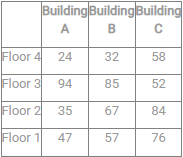
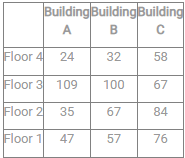
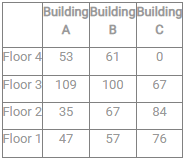

Step 1: 15 tables were added to Floor 3 of each building

Step 2: Both cards were number cards: tables on floor 4 of building C will be divided equally among the floor 4 of buildings A and B

Step 3: The total number of tables on Floor 3 and Floor 4 of building B
100 + 61 = 161
So, the total number of tables on Floor 3 and Floor 4 of building B will be 161.
Hence, the correct option is (C).
Given below are two quantities named A and B. Based on the given information, you have to determine the relation between the two quantities. You should use the given data and your knowledge of Mathematics to choose among the possible answers.Quantity 1: The wrong term in this sequence is:12, 21, 39, 77, 147, 291Quantity 2: The wrong term in this sequence is:35, 110, 327, 984, 2955- a)Quantity 1 > Quantity 2
- b)Quantity 1 < quantity="" />
- c)Quantity 1 ≤ Quantity 2
- d)Quantity 1 ≥ Quantity 2
- e)Either Quantity 1 = Quantity 2 or no relation can be established
Correct answer is option 'B'. Can you explain this answer?
Given below are two quantities named A and B. Based on the given information, you have to determine the relation between the two quantities. You should use the given data and your knowledge of Mathematics to choose among the possible answers.
Quantity 1: The wrong term in this sequence is:
12, 21, 39, 77, 147, 291
Quantity 2: The wrong term in this sequence is:
35, 110, 327, 984, 2955
a)
Quantity 1 > Quantity 2
b)
Quantity 1 < quantity="" />
c)
Quantity 1 ≤ Quantity 2
d)
Quantity 1 ≥ Quantity 2
e)
Either Quantity 1 = Quantity 2 or no relation can be established

|
Naveen Jain answered |
Analysis of Quantity 1
- The sequence is: 12, 21, 39, 77, 147, 291.
- To identify the pattern, let's look for a relationship between the numbers:
- 21 = 12 + 9
- 39 = 21 + 18
- 77 = 39 + 38
- 147 = 77 + 70
- 291 = 147 + 144
- The differences are: 9, 18, 38, 70, 144.
- The differences between these differences do not follow a consistent pattern. Upon further scrutiny, 39 seems to be the wrong term as it doesn’t fit a logical progression.
Analysis of Quantity 2
- The sequence is: 35, 110, 327, 984, 2955.
- Analyzing the pattern:
- 110 = 35 * 3 + 5
- 327 = 110 * 3 - 3
- 984 = 327 * 3 - 3
- 2955 = 984 * 3 - 3
- This sequence appears to follow a consistent multiplication and addition/subtraction pattern.
- All numbers seem to fit their respective positions without any apparent wrong term.
Conclusion
- The wrong term in Quantity 1 is 39, while Quantity 2 has no wrong term.
- Thus, since there is a clear wrong term in Quantity 1 and none in Quantity 2, we can conclude that:
Correct Answer: Quantity 1 < quantity="" />
This leads us to choose option 'B' as the correct option based on the analysis of the sequences.
- The sequence is: 12, 21, 39, 77, 147, 291.
- To identify the pattern, let's look for a relationship between the numbers:
- 21 = 12 + 9
- 39 = 21 + 18
- 77 = 39 + 38
- 147 = 77 + 70
- 291 = 147 + 144
- The differences are: 9, 18, 38, 70, 144.
- The differences between these differences do not follow a consistent pattern. Upon further scrutiny, 39 seems to be the wrong term as it doesn’t fit a logical progression.
Analysis of Quantity 2
- The sequence is: 35, 110, 327, 984, 2955.
- Analyzing the pattern:
- 110 = 35 * 3 + 5
- 327 = 110 * 3 - 3
- 984 = 327 * 3 - 3
- 2955 = 984 * 3 - 3
- This sequence appears to follow a consistent multiplication and addition/subtraction pattern.
- All numbers seem to fit their respective positions without any apparent wrong term.
Conclusion
- The wrong term in Quantity 1 is 39, while Quantity 2 has no wrong term.
- Thus, since there is a clear wrong term in Quantity 1 and none in Quantity 2, we can conclude that:
Correct Answer: Quantity 1 < quantity="" />
This leads us to choose option 'B' as the correct option based on the analysis of the sequences.
A shopkeeper markup his goods 25% above the cost price and gives 12% discount to customer at the time of selling, but he uses 900 gm weight instead of 1 kg. Also at the time of buying he uses 1100 gm instead of 1 kg. Find his overall profit percentage.- a)28.2%
- b)52.3%
- c)34.4%
- d)39.6%
- e)42.8%
Correct answer is option 'C'. Can you explain this answer?
A shopkeeper markup his goods 25% above the cost price and gives 12% discount to customer at the time of selling, but he uses 900 gm weight instead of 1 kg. Also at the time of buying he uses 1100 gm instead of 1 kg. Find his overall profit percentage.
a)
28.2%
b)
52.3%
c)
34.4%
d)
39.6%
e)
42.8%
|
|
Kabir Verma answered |
Given
A shopkeeper markup his goods 25% above the cost price and gives 12% discount to customer at the time of selling.
He uses 900 gm weight instead of 1 kg.
Let cost of 1000 gm = Rs. 1000
Now,
C.P. of 1100 gm = Rs. 1000 ----(1)
C.P. = Rs. 1000
M.P. = Rs. 1250
Discount = 12%
S.P. = Rs. 1100
S.P. of 900 gm = Rs. 1100 ----(2)
To make quantities equal in equation (1) and (2),
Equation (1) Multiply by 9 and Equation (2) Multiply by 11
⇒ Actual C.P. = Rs. 1000 × 9 = Rs. 9000
Actual S.P. = Rs. 1100 × 11 = Rs. 12100
⇒ Profit = 12100 - 9000 = 3100
Profit percentage = 3100 × 100/9000 = 34.4%
Study the following information carefully and answer the below questions.Letters of three five-letter words are written against the first fifteen odd numbers from left to right . All the letters within the word are arranged in alphabetical order.The letters of the word “MOVIE” are placed against the numbers which are multiples of three. Three letters are placed between M and R. The number of letters placed to the right of R is the same as the number of letters placed to the left of C. Four letters are placed between C and U. D is placed fifth to the left of N, which is placed to the right of C. The number of letters placed between D and I is one more than the number of letters placed between W and R. O is one of the letters of the second word placed exactly between N and V.Q. Which of the following statement is not true?- a)C and I are not placed together
- b)Four letters are placed between E and the one which is second to the left of U
- c)M and U are placed together
- d)Not more than one letter is placed between R and V
- e)All the above statements are true
Correct answer is option 'A'. Can you explain this answer?
Study the following information carefully and answer the below questions.
Letters of three five-letter words are written against the first fifteen odd numbers from left to right . All the letters within the word are arranged in alphabetical order.
The letters of the word “MOVIE” are placed against the numbers which are multiples of three. Three letters are placed between M and R. The number of letters placed to the right of R is the same as the number of letters placed to the left of C. Four letters are placed between C and U. D is placed fifth to the left of N, which is placed to the right of C. The number of letters placed between D and I is one more than the number of letters placed between W and R. O is one of the letters of the second word placed exactly between N and V.
Q. Which of the following statement is not true?
a)
C and I are not placed together
b)
Four letters are placed between E and the one which is second to the left of U
c)
M and U are placed together
d)
Not more than one letter is placed between R and V
e)
All the above statements are true
|
|
Rohan Sengupta answered |

We have:
- The letters of the word “MOVIE” are placed against the numbers which are multiples of three.
- Three letters are placed between M and R.
That means, in case (1) R is placed immediate left of I, in case (2) R is placed second to the left of V.
- The number of letters placed to the right of R is the same as the number of letters placed to the left of C.
Based on the above given information we have:

Again, we have:
- Four letters are placed between C and U.
That means, in case (1) U is placed immediate left of M, in case (2) U is placed immediate right of M.
- D is placed fifth to the left of N, which is placed to the right of C.
- The number of letters placed between D and I is one more than the number of letters placed between W and R.
That means, in case (2) D is immediate left of E, case (1) is not valid.
Based on the above given information we have:

Case (1) is not valid as the number of letters placed between D and I is one more than the number of letters between W and R.
Again, we have:
- O is one of the letters of the second word placed exactly between N and V.
Based on the above given information we have:

How many pairs of letters are there in the word “INFORMATION” which have as many letters between them as in the English alphabetical series (both in forward and backward direction)?- a)Two
- b)Three
- c)Four
- d)Five
- e)One
Correct answer is option 'C'. Can you explain this answer?
How many pairs of letters are there in the word “INFORMATION” which have as many letters between them as in the English alphabetical series (both in forward and backward direction)?
a)
Two
b)
Three
c)
Four
d)
Five
e)
One
|
|
Rohan Sengupta answered |
Given Word: INFORMATION

We can use the positional values of letters/alphabets in the English alphabetical series so as to map the letters in an easier manner.
According to the English alphabetical series the positional values of letters are given as follow:

The letters are mapped as shown:

Pairs in the forward direction: NT and FN.
Pairs in the backward direction: NO and MO.
So, we have only four such pairs of letters in the word “INFORMATION” which have as many letters between them as in the English alphabetical series (Both in forward and backward direction). [K1]
NOTE 1: Forward direction means mapping the letters from A to Z from left end to right end and backward direction means mapping the letters from A to Z from right end to left end.
NOTE 2: Alphabetical series is from A to Z and reverse alphabetical series is from Z to A. The series does not occur in a cycle so we either take A to Z (A, B, C...) or Z to A (Z, Y, X…) as per the question.
Hence, the correct option is (C).
Direction: Study the information given below and answer the questions based on it.# means either hour hand or minute hand is at 9$ means either hour hand or minute hand is at 2@ means either hour hand or minute hand is at 3& means either hour hand or minute hand is at 5% mean either hour hand or minute hand is at 12+ means either hour hand or minute hand is at 8Note: If two symbols are given then by default first symbol is considered as hour hand and second one is considered as minute hand . And all time are considered at AM.For eg. #@ ⟶9:15 amQ. Rahul has to catch a train that is scheduled to depart at ‘@#’. It takes him 3 hour and 20 minutes to reach the railway station from his homE. At what time should he leave from his home for the railway station to arrive at the station at least 25 minutes before the departure of the train?- a)+$
- b)&%
- c)&$
- d)&&
- e)%%
Correct answer is option 'E'. Can you explain this answer?
Direction: Study the information given below and answer the questions based on it.
# means either hour hand or minute hand is at 9
$ means either hour hand or minute hand is at 2
@ means either hour hand or minute hand is at 3
& means either hour hand or minute hand is at 5
% mean either hour hand or minute hand is at 12
+ means either hour hand or minute hand is at 8
Note: If two symbols are given then by default first symbol is considered as hour hand and second one is considered as minute hand . And all time are considered at AM.
For eg. #@ ⟶9:15 am
Q. Rahul has to catch a train that is scheduled to depart at ‘@#’. It takes him 3 hour and 20 minutes to reach the railway station from his homE. At what time should he leave from his home for the railway station to arrive at the station at least 25 minutes before the departure of the train?
a)
+$
b)
&%
c)
&$
d)
&&
e)
%%

|
Gowri Dasgupta answered |
Understanding the Departure Time
To solve the problem, we first need to determine the train's departure time based on the symbols provided.
Train Departure Time
- The symbol '@#' translates to 3:9 AM.
- Thus, the train departs at 3:45 AM.
Travel Time to the Station
- Rahul takes 3 hours and 20 minutes to reach the railway station.
- To find out when he should arrive at the station, we need to subtract 25 minutes from the departure time.
Calculating Arrival Time at the Station
- 3:45 AM (departure) - 25 minutes = 3:20 AM.
- Therefore, Rahul needs to arrive at the station by 3:20 AM.
Calculating Leave Time from Home
- Now, we need to subtract the travel time (3 hours and 20 minutes) from the arrival time (3:20 AM).
- 3:20 AM - 3 hours = 12:20 AM.
- 12:20 AM - 20 minutes = 12:00 AM.
Conclusion
- Rahul should leave his home by 12:00 AM to reach the station on time.
- The correct option, which represents 12:00 AM, is '%%'.
Thus, the answer is option 'E'.
To solve the problem, we first need to determine the train's departure time based on the symbols provided.
Train Departure Time
- The symbol '@#' translates to 3:9 AM.
- Thus, the train departs at 3:45 AM.
Travel Time to the Station
- Rahul takes 3 hours and 20 minutes to reach the railway station.
- To find out when he should arrive at the station, we need to subtract 25 minutes from the departure time.
Calculating Arrival Time at the Station
- 3:45 AM (departure) - 25 minutes = 3:20 AM.
- Therefore, Rahul needs to arrive at the station by 3:20 AM.
Calculating Leave Time from Home
- Now, we need to subtract the travel time (3 hours and 20 minutes) from the arrival time (3:20 AM).
- 3:20 AM - 3 hours = 12:20 AM.
- 12:20 AM - 20 minutes = 12:00 AM.
Conclusion
- Rahul should leave his home by 12:00 AM to reach the station on time.
- The correct option, which represents 12:00 AM, is '%%'.
Thus, the answer is option 'E'.
Direction: Read the instructions carefully and answer the question belowThere are three rows i.e., row 1, row 2, and row 3 such that row 2 is to the north of row 3 and row 1 is to the north of row 2. Five persons are sitting in row 1 and 6 persons are sitting in row 2 and three persons are sitting in row 3.Persons sitting in row 1 are facing South. In row 2 the first three persons sitting from West to East are facing North and the last three persons sitting from West to East are facing South. In row 3 first two persons sitting from west to east are facing North and the last person sitting in row 3 is facing South. All the persons are sitting at equal distance.Four persons are sitting between S and L. S is facing P. Two persons are sitting between N and P. L is sitting second to the left of R. M is facing R and sits at one of the ends of the row. The position of Z with respect to S is same as the position of R with respect to L. The position of U with respect to Z is same as the position of Q with respect to M. V is facing X and is sitting to the immediate right of T. W is not an immediate neighbour of N. Y is one of the persons sitting in these rows.Q. Who is sitting second to the left of T?- a)N
- b)W
- c)Y
- d)P
- e)X
Correct answer is option 'C'. Can you explain this answer?
Direction: Read the instructions carefully and answer the question below
There are three rows i.e., row 1, row 2, and row 3 such that row 2 is to the north of row 3 and row 1 is to the north of row 2. Five persons are sitting in row 1 and 6 persons are sitting in row 2 and three persons are sitting in row 3.
Persons sitting in row 1 are facing South. In row 2 the first three persons sitting from West to East are facing North and the last three persons sitting from West to East are facing South. In row 3 first two persons sitting from west to east are facing North and the last person sitting in row 3 is facing South. All the persons are sitting at equal distance.
Four persons are sitting between S and L. S is facing P. Two persons are sitting between N and P. L is sitting second to the left of R. M is facing R and sits at one of the ends of the row. The position of Z with respect to S is same as the position of R with respect to L. The position of U with respect to Z is same as the position of Q with respect to M. V is facing X and is sitting to the immediate right of T. W is not an immediate neighbour of N. Y is one of the persons sitting in these rows.
Q. Who is sitting second to the left of T?
a)
N
b)
W
c)
Y
d)
P
e)
X
|
|
Rohan Sengupta answered |
Arrangement: Three rows (row 1: 5 persons, row 2: 6 persons, row 3: 3 persons).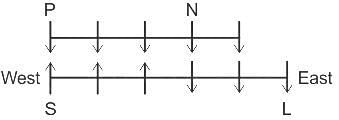
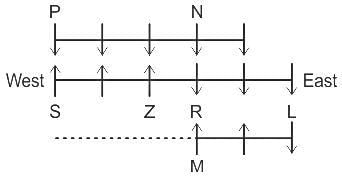
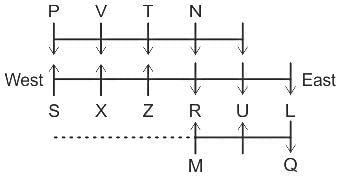
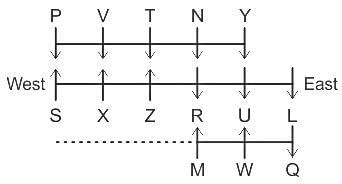
Direction: row 1 – all face south, row 2 – 3 North followed by 3 South (from West to East)
Row 3 - 2 North followed by 1 South (from West to East)
1) Four persons are sitting between S and L.
This is possible in row 2.
2) S is facing P.
3) Two persons are sitting between N and P.
This means that S will be sitting at the west end of row 1 and P and N are sitting in row 1.

4) L is sitting second to the left of R.
5) M is facing R and sits at one of the ends of the row.
6)The position of Z with respect to S is same as the position of R with respect to L.

7) The position of U with respect to Z is same as the position of Q with respect to M.
8) V is facing X and is sitting to the immediate right of T.

9) W is not an immediate neighbour of N.
10) Y is one of the persons sitting in these rows.

So, Y sits second to the left of T.
Hence, the correct option is (C).
Direction: Read the given information carefully and answer the questions given below;Eight boxes P, Q, R, S, T, U, V and W of having a different flavour of cake – strawberry, mango, vanilla, pineapple, chocolate, butterscotch, red velvet and caramel, are placed one above another but not necessarily in the same order.Box W is placed just above the Vanilla flavour box. There are more than three boxes between Pineapple and Vanilla flavour box. There are two boxes between box S and Q and box S does not have Vanilla flavour cake. There is only one box between box Q and W. There are three boxes between box V and W which are having Chocolate flavour cake. There are two boxes between V and U which is having Red velvet flavour cake. The butterscotch flavour cake box is placed just above V. There are more than three boxes between Caramel and Vanilla flavour box. Pineapple flavour box is not on the Top. There is the same number of boxes between box S and U and between box R and T. Strawberry flavour box is placed above the Mango flavour box. Box T is neither Strawberry nor Butterscotch flavour. Box V is placed above W but W is not placed at the bottom.Q. Which box is placed exactly between R and the box which have chocolate flavour cake?- a)Box Q and Box V
- b)Caramel and Red velvet flavour
- c)Red velvet and Box Q
- d)Chocolate and Mango flavour
- e)None of these
Correct answer is option 'C'. Can you explain this answer?
Direction: Read the given information carefully and answer the questions given below;
Eight boxes P, Q, R, S, T, U, V and W of having a different flavour of cake – strawberry, mango, vanilla, pineapple, chocolate, butterscotch, red velvet and caramel, are placed one above another but not necessarily in the same order.
Box W is placed just above the Vanilla flavour box. There are more than three boxes between Pineapple and Vanilla flavour box. There are two boxes between box S and Q and box S does not have Vanilla flavour cake. There is only one box between box Q and W. There are three boxes between box V and W which are having Chocolate flavour cake. There are two boxes between V and U which is having Red velvet flavour cake. The butterscotch flavour cake box is placed just above V. There are more than three boxes between Caramel and Vanilla flavour box. Pineapple flavour box is not on the Top. There is the same number of boxes between box S and U and between box R and T. Strawberry flavour box is placed above the Mango flavour box. Box T is neither Strawberry nor Butterscotch flavour. Box V is placed above W but W is not placed at the bottom.
Q. Which box is placed exactly between R and the box which have chocolate flavour cake?
a)
Box Q and Box V
b)
Caramel and Red velvet flavour
c)
Red velvet and Box Q
d)
Chocolate and Mango flavour
e)
None of these
|
|
Rohan Sengupta answered |
Given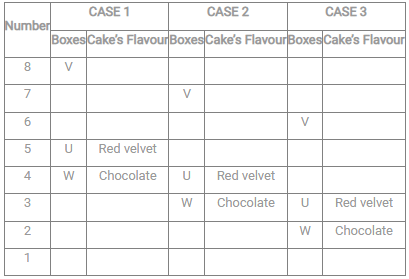
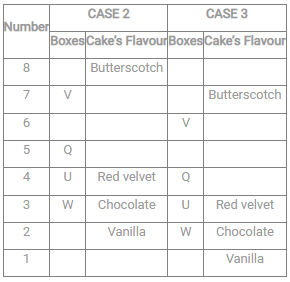
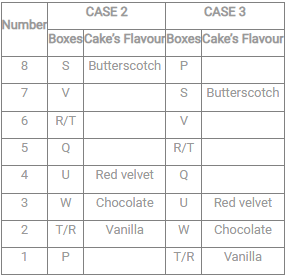
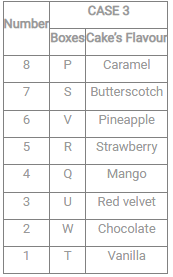
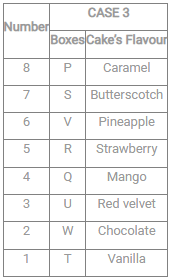
Eight boxes P, Q, R, S, T, U, V and W
The flavour of cake – strawberry, mango, vanilla, pineapple, chocolate, butterscotch, red velvet and caramel.
1) There are three boxes between box V and W which are having Chocolate flavour cake.
2) Box V is placed above W but W is not placed at the bottom.
3) There are two boxes between V and U which is having Red velvet flavour cake.

4) Butterscotch flavour cake box is placed just above V.
(CASE 1 is eliminated as there is no place above V)
5) Box W is placed just above the Vanilla flavour box.
6) There is only one box between box Q and W.

7) There are two boxes between box S and Q and box S does not have Vanilla flavour cake.
8) There is the same number of boxes between box S and U and between box R and T.
(Only 1 place and 1 person left it means P is placed at that position)

9) Strawberry flavour box is placed above the Mango flavour box.
10) There are more than three boxes between Pineapple and Vanilla flavour box.
11) There are more than three boxes between Caramel and Vanilla flavour box.
(In CASE 2, we can not fix 11 and 12 because Only 1 position left. So, Case 2 is eliminated)
12) Pineapple flavour box is not on the Top.
13) Box T is neither Strawberry nor Butterscotch flavour.
(So, Box T is Vanilla flavour)

Final Solution:

Box U which have Red velvet flavour cake and Box Q which have Mango flavour cake is placed between R and the box which have Chocolate flavour box.
Hence, the correct option is (C).
Direction: Five statements labelled A, B, C, 1 and 2 are given below. Among them, statements A, B and C are in the correct order. Identify the positions of 1 and 2 so as to make a logically coherent paragraph.(A) Many great works of literature were produced in ancient India.(B) Rig Veda is the earliest specimen of Indo-European literature.(C) The four Vedas, Sutras, the two Epics- Ramayana and Mahabharata, Smritis, Puranas, Tripitakas, Jaina Agamas and other religious texts are the products of ancient India.(1) Sanskrit, Pali and Prakrit literature made great progress in ancient India.(2) Moreover, there are a number of dramas, prose and poetic works.- a)ABC21
- b)12ABC
- c)2ABC1
- d)ABC12
- e)1ABC2
Correct answer is option 'A'. Can you explain this answer?
Direction: Five statements labelled A, B, C, 1 and 2 are given below. Among them, statements A, B and C are in the correct order. Identify the positions of 1 and 2 so as to make a logically coherent paragraph.
(A) Many great works of literature were produced in ancient India.
(B) Rig Veda is the earliest specimen of Indo-European literature.
(C) The four Vedas, Sutras, the two Epics- Ramayana and Mahabharata, Smritis, Puranas, Tripitakas, Jaina Agamas and other religious texts are the products of ancient India.
(1) Sanskrit, Pali and Prakrit literature made great progress in ancient India.
(2) Moreover, there are a number of dramas, prose and poetic works.
a)
ABC21
b)
12ABC
c)
2ABC1
d)
ABC12
e)
1ABC2

|
Maya Kaur answered |
Understanding the Logical Order of Statements
To create a coherent paragraph, we need to assess how each statement relates to the others. Let’s break down the statements.
Statement A: Introduction to Ancient Indian Literature
- This statement sets the context for the discussion about literature from ancient India.
- It establishes that significant literary works were produced during this period.
Statement B: Specific Example of Literature
- This follows logically after Statement A.
- Mentioning the Rig Veda as the earliest Indo-European literature provides a concrete example of the great works referenced in Statement A.
Statement C: List of Literary Works
- This statement elaborates on the various forms of literature produced, reinforcing the idea introduced in A and supported by B.
- It lists significant texts, showing the richness of ancient Indian literature.
Positioning Statements 1 and 2
- Statement 1 discusses the progress of literature in Sanskrit, Pali, and Prakrit. This can be seen as a continuation of the theme introduced in A, B, and C.
- Statement 2 serves to further elaborate on the diversity and richness of literature, fitting seamlessly after 1.
Correct Order: ABC21
- Thus, the logical sequence is:
- A introduces ancient Indian literature.
- B provides a specific example (Rig Veda).
- C lists significant works from this tradition.
- 2 expands on the types of literature.
- 1 concludes with the progress made in specific languages.
This structured flow ensures clarity and coherence, making option 'A' the correct choice.
To create a coherent paragraph, we need to assess how each statement relates to the others. Let’s break down the statements.
Statement A: Introduction to Ancient Indian Literature
- This statement sets the context for the discussion about literature from ancient India.
- It establishes that significant literary works were produced during this period.
Statement B: Specific Example of Literature
- This follows logically after Statement A.
- Mentioning the Rig Veda as the earliest Indo-European literature provides a concrete example of the great works referenced in Statement A.
Statement C: List of Literary Works
- This statement elaborates on the various forms of literature produced, reinforcing the idea introduced in A and supported by B.
- It lists significant texts, showing the richness of ancient Indian literature.
Positioning Statements 1 and 2
- Statement 1 discusses the progress of literature in Sanskrit, Pali, and Prakrit. This can be seen as a continuation of the theme introduced in A, B, and C.
- Statement 2 serves to further elaborate on the diversity and richness of literature, fitting seamlessly after 1.
Correct Order: ABC21
- Thus, the logical sequence is:
- A introduces ancient Indian literature.
- B provides a specific example (Rig Veda).
- C lists significant works from this tradition.
- 2 expands on the types of literature.
- 1 concludes with the progress made in specific languages.
This structured flow ensures clarity and coherence, making option 'A' the correct choice.
Direction: Read the information carefully and answer the questions below.* means the first subject is to the left of the second subject./means the first subject is to the right of the second subject.%means the first subject and the second subject are neighbours of each other.^ means the first subject and the second subject are not the neighbours of each other.# means number of persons sitting between first subject and second subject.For example, A2#R means, two persons are sitting between A and R.Digit denotes number of places between the given two subjects in that manner.For example, P2*R means, P is second to the left of R.Seven people viz. A, B, C, S, T, X, Y are sitting in a row. Four of them are facing in north direction and remaining are facing in south direction. Persons sitting at the extreme ends are facing in the same direction. No one is sitting to the left of S. C and Y are facing in the opposite direction and C is facing the same direction as T.Further it is given that:A2/B, B%C, B%Y, C2*X, S%X andB2/A.Q. Which of the following does not belong to the group?- a)C
- b)B
- c)A
- d)T
- e)S
Correct answer is option 'B'. Can you explain this answer?
Direction: Read the information carefully and answer the questions below.
* means the first subject is to the left of the second subject.
/means the first subject is to the right of the second subject.
%means the first subject and the second subject are neighbours of each other.
^ means the first subject and the second subject are not the neighbours of each other.
# means number of persons sitting between first subject and second subject.
For example, A2#R means, two persons are sitting between A and R.
Digit denotes number of places between the given two subjects in that manner.
For example, P2*R means, P is second to the left of R.
Seven people viz. A, B, C, S, T, X, Y are sitting in a row. Four of them are facing in north direction and remaining are facing in south direction. Persons sitting at the extreme ends are facing in the same direction. No one is sitting to the left of S. C and Y are facing in the opposite direction and C is facing the same direction as T.
Further it is given that:
A2/B, B%C, B%Y, C2*X, S%X andB2/A.
Q. Which of the following does not belong to the group?
a)
C
b)
B
c)
A
d)
T
e)
S
|
|
Rohan Sengupta answered |
1) Persons sitting at the extreme ends are facing in the same direction.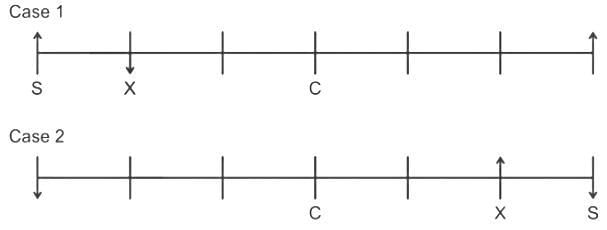
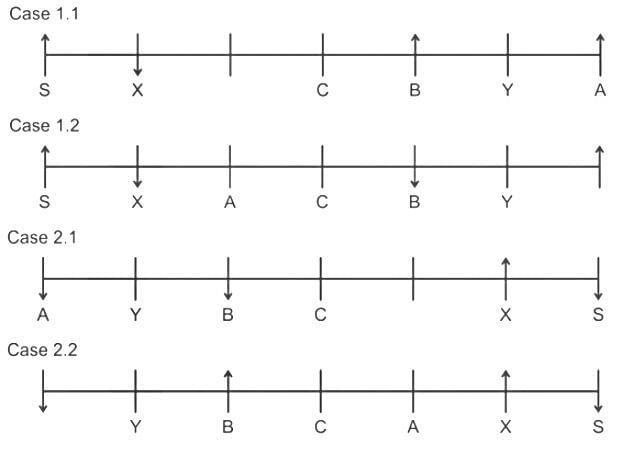
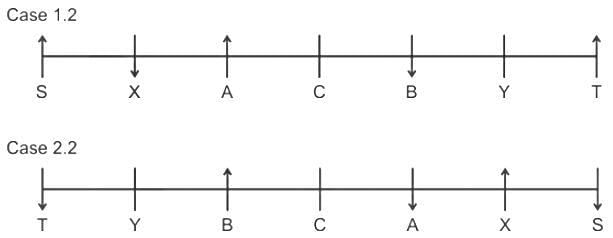

2) Four of them are facing in north direction and remaining are facing in south direction.
3) No one is sitting to the left of S.
4) S%X means S and X are neighbours.
5) C2*X means C is sitting second to the left of X.

6) A2/B means A is sitting second to the right of B.
7) B%C means B is an immediate neighbour of C.
8) B%Y means B and Y are the immediate neighbours.

9) B2/A means B is sitting second to the right of A.
Therefore case 1.1 and 2.1 gets eliminated.

10) C and Y are facing in opposite direction and C is facing same direction as T.
Now, in case 2.2 if C face the same direction as T i.e. South then there will be 4 people in the row facing south. So, case 2.2 eliminates.

Except B, all are facing in North direction.
Hence, the correct option is (B).
Monetary policy is concerned with ________- a)changes in the supply of money
- b)buying and selling of financial instruments
- c)reducing unemployment
- d)changes in the supply of money & reducing unemployment
- e)Other than those given as options
Correct answer is option 'A'. Can you explain this answer?
Monetary policy is concerned with ________
a)
changes in the supply of money
b)
buying and selling of financial instruments
c)
reducing unemployment
d)
changes in the supply of money & reducing unemployment
e)
Other than those given as options
|
|
Kavya Saxena answered |
The correct answer changes in the supply of money.
- Monetary policy is concerned with changes in the supply of money.
Monetary policy:
- It refers to the use of monetary instruments under the control of the central bank to regulate magnitudes such as interest rates, money supply, and availability of credit with a view to achieving the ultimate objective of economic policy.
- The Monetary Policy Committee (MPC) constituted by the Central Government under Section 45ZB determines the policy interest rate required to achieve the inflation target.
- The primary objective of monetary policy is to maintain price stability while keeping in mind the objective of growth. Price stability is a necessary precondition to sustainable growth.
- The Reserve Bank of India (RBI) is vested with the responsibility of conducting monetary policy. This responsibility is explicitly mandated under the Reserve Bank of India Act, 1934.
- Monetary policy is RBI's initiative to achieve price stability, financial stability, and adequate availability of credit for growth.
- It is also used to manage economic growth, unemployment, and inflation.
- Objectives of Monetary Policy:
- To regulate the money supply in the economy.
- To attain price stability of money in the market.
- To promote economic growth and development.
- To maintain the neutrality of money.
- To promote employment.
- Monetary policies include Bank Rate, Cash Reserve Ratio (CRR), Statutory Liquidity Ratio (SLR), Repo Rate, Reverse Repo Rate, and Open Market Operations.
IRDAI permitted insurance companies to have exposure to financial and insurance activities upto ____ of investment assets.- a)40%
- b)50%
- c)30%
- d)25%
- e)20%
Correct answer is option 'C'. Can you explain this answer?
IRDAI permitted insurance companies to have exposure to financial and insurance activities upto ____ of investment assets.
a)
40%
b)
50%
c)
30%
d)
25%
e)
20%
|
|
Anaya Patel answered |
The Insurance Regulatory and Development Authority of India (IRDAI) permitted insurance companies to have exposure to financial and insurance activities up to 30% of investment assets.
The authority in the exercise of its powers conferred under Regulation 14(2) of the IRDAI (Investment) Regulations, 2016, permits all insurers to have exposure to financial and insurance activities (as per section K of NIC classification) up to 30 per cent of investment assets.
The price of rice decreased by 20% and then increased by 50%. By what percent the consumption need to be increased/decreased so that the expenditure on rice remains same?- a)16.67
- b)20.24
- c)15.55
- d)60.12
- e)54.52
Correct answer is option 'A'. Can you explain this answer?
The price of rice decreased by 20% and then increased by 50%. By what percent the consumption need to be increased/decreased so that the expenditure on rice remains same?
a)
16.67
b)
20.24
c)
15.55
d)
60.12
e)
54.52
|
|
Rohan Sengupta answered |
Let the price be 100Rs.
First decreased (100-20 = 80) then increased (80+80×50%)by then the value will be 120Rs.
Percentage to be decreased will be 120-100 / 120 = 16.667
Direction: Read the following information carefully and answer the question that follow.There are three buildings, A, B and C, and each building has four floors, where topmost floor is numbered as floor 4 and bottommost floor is numbered as floor 1. Each floor has different number of tables. Building A is in west of building B, and building B is in west of building C.Number of tables in each floor is given as follows:Floor 4: 24, 32, 58Floor 3: 94, 85, 52Floor 2: 35, 67, 84Floor 1: 47, 57, 76A deck of 11 cards is taken which contains 5 face cards, 5 number cards and 1 joker card. Two cards are picked and the following conditions are to be followed.I. If both cards are face cards, then 20 tables on floor 2 of building C will be shifted to the floor 4 of building B.II. If both cards are number cards, then tables on floor 4 of building C will be divided equally among the floor 4 of buildings A and B.III. If first card is face card and second card is number card, then 15 tables on floor 3 of building B will be shifted to the floor 4 of building A.IV. If first card is number card and second card is face card, then all the tables on floor 2 will be equally divided among floor 2 of all the three buildings.V. If a Joker card is picked, then 10 chairs will be added to each floor of each building.Q. First 5 tables were removed from each floor of building A and then cards were picked. If one of the cards was Joker, then what is the total number of tables on Floor 4 of building A?- a)89
- b)58
- c)42
- d)76
- e)29
Correct answer is option 'E'. Can you explain this answer?
Direction: Read the following information carefully and answer the question that follow.
There are three buildings, A, B and C, and each building has four floors, where topmost floor is numbered as floor 4 and bottommost floor is numbered as floor 1. Each floor has different number of tables. Building A is in west of building B, and building B is in west of building C.
Number of tables in each floor is given as follows:
Floor 4: 24, 32, 58
Floor 3: 94, 85, 52
Floor 2: 35, 67, 84
Floor 1: 47, 57, 76
A deck of 11 cards is taken which contains 5 face cards, 5 number cards and 1 joker card. Two cards are picked and the following conditions are to be followed.
I. If both cards are face cards, then 20 tables on floor 2 of building C will be shifted to the floor 4 of building B.
II. If both cards are number cards, then tables on floor 4 of building C will be divided equally among the floor 4 of buildings A and B.
III. If first card is face card and second card is number card, then 15 tables on floor 3 of building B will be shifted to the floor 4 of building A.
IV. If first card is number card and second card is face card, then all the tables on floor 2 will be equally divided among floor 2 of all the three buildings.
V. If a Joker card is picked, then 10 chairs will be added to each floor of each building.
Q. First 5 tables were removed from each floor of building A and then cards were picked. If one of the cards was Joker, then what is the total number of tables on Floor 4 of building A?
a)
89
b)
58
c)
42
d)
76
e)
29

|
Hridoy Sharma answered |
Calculation:
Tables on Floor 4 of Building A:
First, let's calculate the total number of tables on Floor 4 of Building A before any changes are made.
Total number of tables on Floor 4 of Building A = 24 (from tables on Floor 4) + 47 (from tables on Floor 1) = 71 tables
Impact of Joker card:
When a Joker card is picked, 10 chairs are added to each floor of each building. Since only tables were removed from Building A initially, the total number of tables on Floor 4 of Building A remains the same.
Therefore, after picking the Joker card and adding 10 chairs to each floor, the total number of tables on Floor 4 of Building A remains at 71 tables.
Therefore, the total number of tables on Floor 4 of Building A after removing the first 5 tables and picking the Joker card will be 71 tables.
Hence, the correct answer is option 'E) 29'.
Tables on Floor 4 of Building A:
First, let's calculate the total number of tables on Floor 4 of Building A before any changes are made.
Total number of tables on Floor 4 of Building A = 24 (from tables on Floor 4) + 47 (from tables on Floor 1) = 71 tables
Impact of Joker card:
When a Joker card is picked, 10 chairs are added to each floor of each building. Since only tables were removed from Building A initially, the total number of tables on Floor 4 of Building A remains the same.
Therefore, after picking the Joker card and adding 10 chairs to each floor, the total number of tables on Floor 4 of Building A remains at 71 tables.
Therefore, the total number of tables on Floor 4 of Building A after removing the first 5 tables and picking the Joker card will be 71 tables.
Hence, the correct answer is option 'E) 29'.
Directions: The given question has three blanks, each blank indicating that something has been omitted. Choose the combination of words that would fit in the blanks correctly.Q. The 'Middle Kingdom' evidently feels __________ to adopt such pressures after it has succeeded in _________ territories across its maritime borders, using _________ diplomatic, economic, and military pressures.A. DebilitateB. EmboldenedC. AnnexingD. CoactiveE. Coercive- a)ACE
- b)ACD
- c)BCE
- d)BCD
- e)BDE
Correct answer is option 'C'. Can you explain this answer?
Directions: The given question has three blanks, each blank indicating that something has been omitted. Choose the combination of words that would fit in the blanks correctly.
Q. The 'Middle Kingdom' evidently feels __________ to adopt such pressures after it has succeeded in _________ territories across its maritime borders, using _________ diplomatic, economic, and military pressures.
A. Debilitate
B. Emboldened
C. Annexing
D. Coactive
E. Coercive
a)
ACE
b)
ACD
c)
BCE
d)
BCD
e)
BDE
|
|
Rohan Sengupta answered |
Let's understand the meaning of these words:
- Emboldened: given (someone) the courage or confidence to do something
- Annexing: taking possession of an area of land or a country, usually by force or without permission
- Coercive: using force to persuade people to do things that they are unwilling to do
It should read as:
The 'Middle Kingdom' evidently feels emboldened to adopt such pressures after it has succeeded in annexing territories across its maritime borders, using coercive diplomatic, economic, and military pressures.
Hence, the correct option is (C).
A box contains 3 blue caps and 2 black caps. 2 caps are drawn from the box without replacement. Then, find the probability that the drawn caps are in alternate color.- a)2/5
- b)3/5
- c)1/7
- d)1/9
- e)1/8
Correct answer is option 'B'. Can you explain this answer?
A box contains 3 blue caps and 2 black caps. 2 caps are drawn from the box without replacement. Then, find the probability that the drawn caps are in alternate color.
a)
2/5
b)
3/5
c)
1/7
d)
1/9
e)
1/8
|
|
Kavya Saxena answered |
Given
Total number of caps = 5
P(E) = 

E1: Event that first drawn cap is blue and second is black.
E2: Event that first drawn cap is black and second is blue.
⇒ P(E1) = (3/5) x (2/4) = (6/20)
⇒ P(E2) = (2/5) x (3/4) = (6/20)
⇒ P(E) = P(E1) + P(E2)
As we know
= (6/20) + (6/20)
= 12/20
= 3/5
Directions: Answer the questions based on the information given below.The population of town A was 180600 in the third year and it increased by 5% and 7.5% in the second and third year respectively. The population of town B increased by 25% in the second year and in the second year it was equal to 150% of the population of town A in the first year. After taking population control measures, town B succeeds in controlling the population as the growth rate in the third year was half of that of the previous year. The area of town C is 1250 km2 and the population density for the second year was 250. The growth rate for town C was 11.11% and 10% for the second and the third year respectively. The difference between the total population of town D in the third year and the total population of town A in the first year is the same as the difference between the total population of town B in the second year and the total population of town D in the third year. The area of town D is 20% that of town C.Note: population density of a town is calculated as The total population of the town/Total area of the townWhat is the population density of town D for the third year ?- a)300 per km2
- b)400 per km2
- c)500 per km2
- d)700 per km2
- e)800 per km2
Correct answer is option 'E'. Can you explain this answer?
Directions: Answer the questions based on the information given below.
The population of town A was 180600 in the third year and it increased by 5% and 7.5% in the second and third year respectively. The population of town B increased by 25% in the second year and in the second year it was equal to 150% of the population of town A in the first year. After taking population control measures, town B succeeds in controlling the population as the growth rate in the third year was half of that of the previous year. The area of town C is 1250 km2 and the population density for the second year was 250. The growth rate for town C was 11.11% and 10% for the second and the third year respectively. The difference between the total population of town D in the third year and the total population of town A in the first year is the same as the difference between the total population of town B in the second year and the total population of town D in the third year. The area of town D is 20% that of town C.
Note: population density of a town is calculated as The total population of the town/Total area of the town
What is the population density of town D for the third year ?
a)
300 per km2
b)
400 per km2
c)
500 per km2
d)
700 per km2
e)
800 per km2
|
|
Kabir Verma answered |
The population of town A in the third year = 180600
It increased by 3% and 7.5% in the second and third year respectively.
The population of town A in the second year = 180600/1.075 = 168000
The population of town A in the first year = 168000/1.05 = 160000
The population of town B in the second year was equal to 150% of the population of town A in the first year.
The population of town B in the second year = 160000 × 1.50 = 240000
The population of town B increased by 25% in the second year.
Therefore, the population of town B in the first year = 240000/1.25 = 192000
The population growth rate of town B in the third year was half of that of the previous year means 25/2 = 12.5%
So, the population of town B in the third year = 240000 × 1.125 = 270000
The area of town C is 1250 km2 and the population density for the second year was 250.
Therefore, the population of town C in the second year = 250 × 1250 = 312500
The growth rate for town C was 11.11% and 10% for the second and the third year respectively.
So, the population of town C in the first year = 312500/1.111 = 281250
The population of town C in the third year = 312500 × 1.10 = 343750
Let the total population of town D in the third year = x
The difference between the total population of town D in the third year and the total population of town A in the first year = The difference between the total population of town B in the second year and the total population of town D in the third year.
So, x - 160000 = 240000 - x
x = 200000
Area of city D = 20% of 1250 = 250 km2
Population density of town D for the third year = 200000/250 = 800 per km2
Hence, the correct answer is 800 per km2.
Direction: In the following question, out of the five alternatives, select the alternative which will improve the underlined part of the sentence. In case no improvement is needed, select the "No improvement".Chari along with other astronauts, will form the Artemis Team and help pave the way for the next lunar missions, including sending the first woman and next man to walk on the lunar surface in 2024.- a)And helped pave
- b)And would help pave
- c)And help paved
- d)And help paving
- e)No improvement
Correct answer is option 'E'. Can you explain this answer?
Direction: In the following question, out of the five alternatives, select the alternative which will improve the underlined part of the sentence. In case no improvement is needed, select the "No improvement".
Chari along with other astronauts, will form the Artemis Team and help pave the way for the next lunar missions, including sending the first woman and next man to walk on the lunar surface in 2024.
a)
And helped pave
b)
And would help pave
c)
And help paved
d)
And help paving
e)
No improvement
|
|
Rohan Sengupta answered |
The given sentence is grammatically correct. So, there is no need to improve the sentence.
The verbs used in the sentence is in simple future tense. The formula for the simple future is will + [root form of verb].
When two or more verbs have the same subject, the verbs must be parallel. Parallel verbs mean the verbs used in a sentence should all be the same tense.
Before 'and', the verb 'will form' is used, and 'help pave' is used after (the verb 'will doesn't have to be repeated twice'.
So, 'No improvement' is the correct option.
Direction: In the given question, a part of the sentence is printed in bold. Below the sentence, three alternatives to the bold part are given which may help improve the sentence. Choose the option that reflects the correct use of the phrase in the context of the sentence. In case the given sentence is correct, your answer is (E) i.e. No correction required.Q. Why should one be proud of anything, since we’re all products of nature and nurture, neither in that we ourselves are responsible for?(i) nor in that we ourselves are responsible for(ii) either of which we are ourselves are responsible for(iii) neither of which we ourselves are responsible for- a)Only (i)
- b)Only (ii)
- c)Only (iii)
- d)(i) and (ii)
- e)No correction required
Correct answer is option 'C'. Can you explain this answer?
Direction: In the given question, a part of the sentence is printed in bold. Below the sentence, three alternatives to the bold part are given which may help improve the sentence. Choose the option that reflects the correct use of the phrase in the context of the sentence. In case the given sentence is correct, your answer is (E) i.e. No correction required.
Q. Why should one be proud of anything, since we’re all products of nature and nurture, neither in that we ourselves are responsible for?
(i) nor in that we ourselves are responsible for
(ii) either of which we are ourselves are responsible for
(iii) neither of which we ourselves are responsible for
a)
Only (i)
b)
Only (ii)
c)
Only (iii)
d)
(i) and (ii)
e)
No correction required

|
Rutuja Gupta answered |
Explanation:
Original Sentence: Why should one be proud of anything, since we’re all products of nature and nurture, neither in that we ourselves are responsible for?
Correction:
- Option (iii): neither of which we ourselves are responsible for
The correct phrase to use in this context is "neither of which we ourselves are responsible for." This conveys the idea that we are not responsible for being products of nature and nurture, so there is no reason to be proud. The phrase "neither in that" in the original sentence is incorrect and does not fit the context. Option (iii) provides the appropriate correction to improve the sentence.
Direction: Read the following information carefully and answer the question that follow.There are three buildings, A, B and C, and each building has four floors, where topmost floor is numbered as floor 4 and bottommost floor is numbered as floor 1. Each floor has different number of tables. Building A is in west of building B, and building B is in west of building C.Number of tables in each floor is given as follows:Floor 4: 24, 32, 58Floor 3: 94, 85, 52Floor 2: 35, 67, 84Floor 1: 47, 57, 76A deck of 11 cards is taken which contains 5 face cards, 5 number cards and 1 joker card. Two cards are picked and the following conditions are to be followed.I. If both cards are face cards, then 20 tables on floor 2 of building C will be shifted to the floor 4 of building B.II. If both cards are number cards, then tables on floor 4 of building C will be divided equally among the floor 4 of buildings A and B.III. If first card is face card and second card is number card, then 15 tables on floor 3 of building B will be shifted to the floor 4 of building A.IV. If first card is number card and second card is face card, then all the tables on floor 2 will be equally divided among floor 2 of all the three buildings.V. If a Joker card is picked, then 10 chairs will be added to each floor of each building.Q. There was a wedding in building A. So, for arrangements all the tables of building A were divided equally on each floor of building A. After the arrangements cards were picked. If both cards are face cards, then what is the difference in number of tables on floor 2 of building C and number of tables on floor 3 of building A?- a)12
- b)2
- c)8
- d)14
- e)16
Correct answer is option 'D'. Can you explain this answer?
Direction: Read the following information carefully and answer the question that follow.
There are three buildings, A, B and C, and each building has four floors, where topmost floor is numbered as floor 4 and bottommost floor is numbered as floor 1. Each floor has different number of tables. Building A is in west of building B, and building B is in west of building C.
Number of tables in each floor is given as follows:
Floor 4: 24, 32, 58
Floor 3: 94, 85, 52
Floor 2: 35, 67, 84
Floor 1: 47, 57, 76
A deck of 11 cards is taken which contains 5 face cards, 5 number cards and 1 joker card. Two cards are picked and the following conditions are to be followed.
I. If both cards are face cards, then 20 tables on floor 2 of building C will be shifted to the floor 4 of building B.
II. If both cards are number cards, then tables on floor 4 of building C will be divided equally among the floor 4 of buildings A and B.
III. If first card is face card and second card is number card, then 15 tables on floor 3 of building B will be shifted to the floor 4 of building A.
IV. If first card is number card and second card is face card, then all the tables on floor 2 will be equally divided among floor 2 of all the three buildings.
V. If a Joker card is picked, then 10 chairs will be added to each floor of each building.
Q. There was a wedding in building A. So, for arrangements all the tables of building A were divided equally on each floor of building A. After the arrangements cards were picked. If both cards are face cards, then what is the difference in number of tables on floor 2 of building C and number of tables on floor 3 of building A?
a)
12
b)
2
c)
8
d)
14
e)
16

|
Hridoy Sharma answered |
Calculation:
Building A:
- Total tables in Building A = 24 + 94 + 35 + 47 = 200 tables
- Tables divided equally on each floor = 200/4 = 50 tables per floor
Building C:
- Total tables on floor 2 of Building C = 58 tables
- Total tables on floor 3 of Building C = 52 tables
Difference:
- Difference = 58 - 52 = 6 tables
Therefore, the difference in number of tables on floor 2 of building C and number of tables on floor 3 of building A is 6 tables.
Building A:
- Total tables in Building A = 24 + 94 + 35 + 47 = 200 tables
- Tables divided equally on each floor = 200/4 = 50 tables per floor
Building C:
- Total tables on floor 2 of Building C = 58 tables
- Total tables on floor 3 of Building C = 52 tables
Difference:
- Difference = 58 - 52 = 6 tables
Therefore, the difference in number of tables on floor 2 of building C and number of tables on floor 3 of building A is 6 tables.
Below questions consist of some numbers in two rows. Resultant of each row can be determined by performing some operations. Study the following information carefully and answer the below questions.Condition:I. If an even number is followed by a number which is a multiple of 3, then four is added to the positive difference of both numbers.II. If an even number is followed by a number which is not a multiple of 3, then five is subtracted from the sum of both numbers.III. If an odd number(not a prime number) is followed by a prime number, then the product of the tenth digit of both numbers is taken.IV. If a prime number is followed by a composite number, then the product of unit digits of both numbers is taken.V. If a prime number is followed by another prime number, then the sum of both numbers is taken.Note: If more than one condition follows then only one condition is applied in the given sequence.Q. If Y is the result of row 1 then what is the resultant of row 2?15 31 117 26 Y- a)24
- b)41
- c)39
- d)45
- e)None of these
Correct answer is option 'E'. Can you explain this answer?
Below questions consist of some numbers in two rows. Resultant of each row can be determined by performing some operations. Study the following information carefully and answer the below questions.
Condition:
I. If an even number is followed by a number which is a multiple of 3, then four is added to the positive difference of both numbers.
II. If an even number is followed by a number which is not a multiple of 3, then five is subtracted from the sum of both numbers.
III. If an odd number(not a prime number) is followed by a prime number, then the product of the tenth digit of both numbers is taken.
IV. If a prime number is followed by a composite number, then the product of unit digits of both numbers is taken.
V. If a prime number is followed by another prime number, then the sum of both numbers is taken.
Note: If more than one condition follows then only one condition is applied in the given sequence.
Q. If Y is the result of row 1 then what is the resultant of row 2?
15 31 11
7 26 Y
a)
24
b)
41
c)
39
d)
45
e)
None of these
|
|
Rohan Sengupta answered |
15 31 11
From condition III: (1 x 3) = 3
From condition V: (3 + 11) = 14
7 26 Y
From condition IV: (7 x 6) = 42
From condition II: (42 + 14) – 5 = 51
Direction: Following is the data required the number of students who like coffee, tea and cold drink.18 student like all three and 14 student none of them. there are 200 students in total and 28% of them like only coffee. 30 students like both coffee and tea and 55% of all students like coffee. The number of students who like both Tea and cold drink but not coffee is 25% of the number of students who like both coffee and cold drink but not Tea. The ratio of number of students who like only tea to that who like only cold drink is 4 : 3.Q. What is the ratio of the number of students who like only coffee to the number of students who like only Tea?- a)7 : 5
- b)9 : 7
- c)5 : 3
- d)3 : 1
- e)11 : 9
Correct answer is option 'A'. Can you explain this answer?
Direction: Following is the data required the number of students who like coffee, tea and cold drink.
18 student like all three and 14 student none of them. there are 200 students in total and 28% of them like only coffee. 30 students like both coffee and tea and 55% of all students like coffee. The number of students who like both Tea and cold drink but not coffee is 25% of the number of students who like both coffee and cold drink but not Tea. The ratio of number of students who like only tea to that who like only cold drink is 4 : 3.
Q. What is the ratio of the number of students who like only coffee to the number of students who like only Tea?
a)
7 : 5
b)
9 : 7
c)
5 : 3
d)
3 : 1
e)
11 : 9
|
|
Rohan Sengupta answered |
Number of students who like only coffee = (28/100)×200=56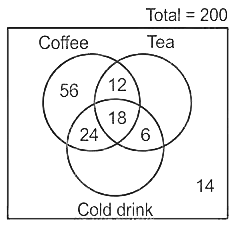
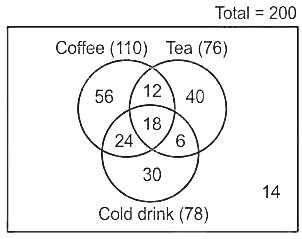
Number of students and who like coffee = (55/100)×200=110
Number of students who like both coffee and tea but not cold drink = 30 - 18 = 12
Number of students who like both coffee and cold drink but not Tea = 110 - 56 - 30 = 24
Number of students who would like both tea and cold drink but not coffee = (25/100) ×24=6

Number of student whole life at least one out of Coffee, tea and cold drink = 200 - 14 = 186
Number of student who like either only tea or only cold drink = 186 - (56 + 12 + 24 + 18 + 6) = 70
Number of students who like only tea =4/7×70=40
Number of student who like only cold drink = 70 - 40 = 30
Complete the Venn diagram:

Required ratio = 56 : 40 = 7 : 5
Hence, the correct option is (A).
Which of the following became India's first district to cover 100% of households under the ABPMJAY SEHAT scheme?- a)Rampur
- b)Indore
- c)Katra
- d)Samba
- e)Pathankot
Correct answer is option 'D'. Can you explain this answer?
Which of the following became India's first district to cover 100% of households under the ABPMJAY SEHAT scheme?
a)
Rampur
b)
Indore
c)
Katra
d)
Samba
e)
Pathankot
|
|
Rohan Sengupta answered |
In the Union Territory of Jammu and Kashmir, the Samba district of the Jammu division has become the first district in India to cover 100% of households under the Ayushman Bharat Pradhan Mantri Jan Arogya Yojana (ABPMJAY)- SEHAT scheme.
The district achieved this milestone after the conclusion of the special registration drive organized by the State Health Agency (SHA) from April 11 to April 21 in all BDO offices across the district which was aimed to cover all families under the ABPMJAY SEHAT scheme in the district.
The Samba district has a total of 62,641 families with 3,04,510 people eligible for ABPM-JAY SEHAT golden cards.
Two people A and B start simultaneously from points P and Q towards Q and P respectively. After meeting for the first time, A and B take 8 hours and 18 hours respectively to reach their destination. If A travels at a speed of 96 kmph, find the speed of B.- a)32 kmph
- b)48 kmph
- c)56 kmph
- d)64 kmph
- e)None of these
Correct answer is option 'D'. Can you explain this answer?
Two people A and B start simultaneously from points P and Q towards Q and P respectively. After meeting for the first time, A and B take 8 hours and 18 hours respectively to reach their destination. If A travels at a speed of 96 kmph, find the speed of B.
a)
32 kmph
b)
48 kmph
c)
56 kmph
d)
64 kmph
e)
None of these
|
|
Rohan Sengupta answered |
When A and B meet for the first time, both of them have travelled for the same time
As a result, the distance covered by them will be equal to the ratio of their speeds
Let the time taken to meet for the first time be ‘T’ hours from the time of the start
A and B would take (T + 8) and (T + 18) hours respectively to cover the entire distance
⇒ Ratio of the total time taken by A and B = (T + 8) : (T + 18)
If the distance is constant, then the speed is inversely proportional to Time
⇒ Ratio of speeds of A : B = (T + 18) : (T + 8)
Given: A’s speed = 96 km/hr
When they meet for the first time, A should have covered (96 × T) kms which is the distance which B will cover in 18 hours

⇒ Ratio of the speeds of A and B = 96 : (96T/18)
⇒ (T + 18) : (T + 8) = 96 : (96T/18)
⇒ (T + 18) : (T + 8) = 18 : T
⇒ (T + 18) × T = (T + 8) × 18
⇒ T2 + 18T = 18T + 144
⇒ T2 = 144
⇒ T = 12 hours
Speed of B = ((96x12)/18) kmph = 64 kmph
∴ Speed of B = 64 kmph
Hence, the correct option is (D).
Which of the following are the components of the Pradhan Mantri Awas Yojana-Urban?- a)Rehabilitation of existing slum dwellers through private participation
- b)Credit Linked Subsidy Scheme (CLSS) for Economically Weaker Sections, Lower Income Groups, and middle-income group (MIG)
- c)Affordable housing in partnership
- d)Subsidy for beneficiary-led individual house construction
- e)All of the above are the components of the scheme
Correct answer is option 'E'. Can you explain this answer?
Which of the following are the components of the Pradhan Mantri Awas Yojana-Urban?
a)
Rehabilitation of existing slum dwellers through private participation
b)
Credit Linked Subsidy Scheme (CLSS) for Economically Weaker Sections, Lower Income Groups, and middle-income group (MIG)
c)
Affordable housing in partnership
d)
Subsidy for beneficiary-led individual house construction
e)
All of the above are the components of the scheme
|
|
Kavya Saxena answered |
The Pradhan Mantri Awas Yojana (Urban) Programme launched by the Ministry of Housing and Urban Poverty Alleviation (MoHUPA), in Mission mode envisions the provision of Housing for All by 2022 when the Nation completes 75 years of its Independence.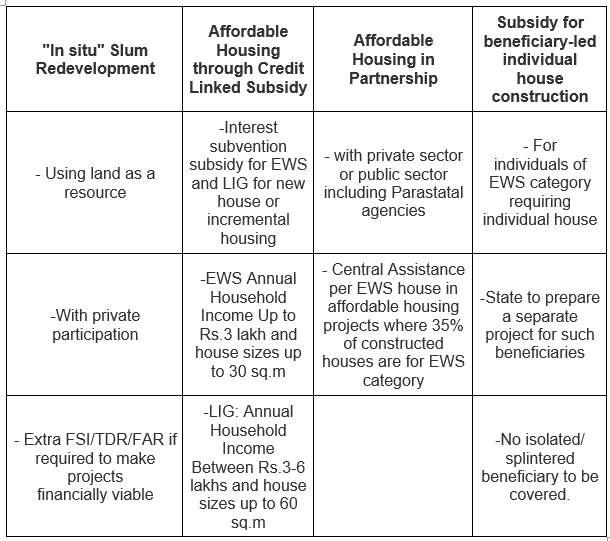
The following are the four components of the Pradhan Mantri Awas Yojana-Urban-

Directions: Study the following information carefully to answer the given questions:Six persons are sitting around a table that is in the shape of a regular hexagon. Each of these people is sitting on the vertices of this hexagon and facing the centre. L, M, N, O, P, and Q are these six persons. Also, these people like six different colours namely, white, green, brown, red, blue, and yellow, but not necessarily in the same order.The person who likes red colour is sitting second to the left of O. P is the immediate neighbour of M. The person who likes Yellow is an immediate neighbour of M. L and Q do not like blue colour. P does not like Yellow. M is sitting second to the right of the person who likes the blue colour. N is sitting second to the left of L. Only one person is sitting between Q and the person who likes brown colour. The person who likes the green colour is sitting second to the left of P.Who likes the Yellow colour?- a)M
- b)N
- c)L
- d)P
- e)Q
Correct answer is option 'B'. Can you explain this answer?
Directions: Study the following information carefully to answer the given questions:
Six persons are sitting around a table that is in the shape of a regular hexagon. Each of these people is sitting on the vertices of this hexagon and facing the centre. L, M, N, O, P, and Q are these six persons. Also, these people like six different colours namely, white, green, brown, red, blue, and yellow, but not necessarily in the same order.
The person who likes red colour is sitting second to the left of O. P is the immediate neighbour of M. The person who likes Yellow is an immediate neighbour of M. L and Q do not like blue colour. P does not like Yellow. M is sitting second to the right of the person who likes the blue colour. N is sitting second to the left of L. Only one person is sitting between Q and the person who likes brown colour. The person who likes the green colour is sitting second to the left of P.
Who likes the Yellow colour?
a)
M
b)
N
c)
L
d)
P
e)
Q
|
|
Kavya Saxena answered |
1) M is sitting second to the right of the person who likes the blue colour.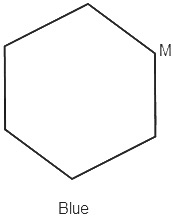
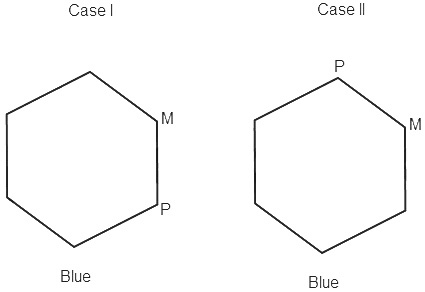
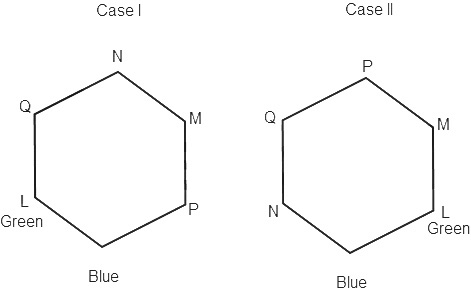
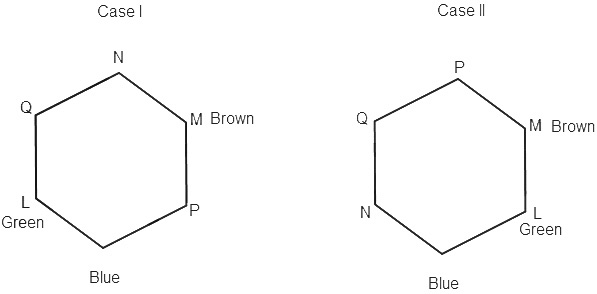
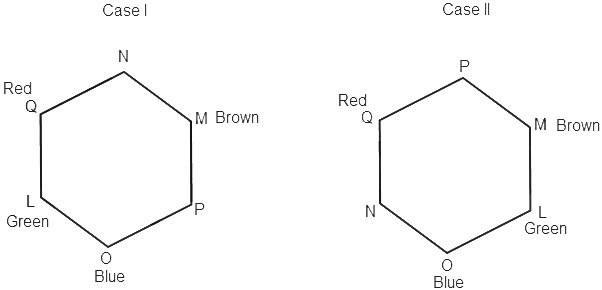
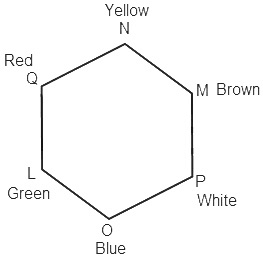
(We can randomly select a seat for the person who likes the blue colour and then we can place M accordingly.)

2) P is the immediate neighbour of M.
(There are two possibilities here:
Case I: P is sitting to the immediate right of M.
Case II: P is sitting to the immediate left of M.)

3) The person who likes the green colour is sitting second to the left of P.
(Case I: The person who likes green colour is sitting to the immediate left of the person who likes blue colour.
Case II: The person who likes green colour is sitting to the immediate left of M.)
4) N is sitting second to the left of L.
5) L and Q do not like the blue colour.
(Case I: There is only one possibility to place N and L i.e. L is sitting to the immediate left of the person who likes blue colour and N is sitting to the immediate right of M.
Case II: There is only one possibility to place L and N in this case as well, i.e. L is sitting to the immediate left of M and N is sitting to the immediate left of the person who likes blue colour. Also, as Q does not like the blue colour, implies, in both cases, Q is sitting second to the left of M as it is the only possibility.)

6) Only one person is sitting between Q and the person who likes the brown colour.
(In both the cases, it means that M likes brown colour as the person who likes blue colour is sitting second to the left of Q.)

7) The person who likes red colour is sitting second to the left of O.
(In both cases, there is only one place left for O i.e. the seat that is second to the left of M. Also, in both cases, Q likes red colour as O likes blue colour.)

8) The person who likes Yellow is an immediate neighbour of M.
9) P does not like Yellow.
(In case II, P will be the person who likes Yellow colour which is not possible. Hence, case II is not true.
In case I, N likes Yellow and P likes White.)

Clearly, N likes Yellow colour.
Direction: Read the following information carefully and answer the questions given below:There are four boys namely Varun, Vinayak, Shivam, and Anuj, and four girls namely Bhumica, Jayanti, Sheetal, and Karishma in a group and each can complete a piece of work in a different number of days. Jayanti can complete the piece of work in 12 days. The number of days taken by Shivam to complete the work is 25% more than the number of days taken by Jayanti to complete the work. The ratio of the number of days taken by Shivam and Varun to complete the work is 3 ∶ 4. The number of days taken by Varun to complete the work is 100% more than the number of days taken by Bhumica to complete the work. The efficiency of Bhumica is 50% more than the efficiency of Karishma. The ratio of the number of days taken by Varun, Vinayak, and Sheetal are 5 ∶ 4 ∶ 2 respectively. The number of days taken by Anuj to complete the work is 50% more than the number of days taken by Sheetal to complete the work.Q. If Karishma and Varun work on alternate days starting with Karishma, find the number of days taken by them to complete the work.- a)19 days
- b)17 days
- c)25 days
- d)18 days
- e)None of these
Correct answer is option 'B'. Can you explain this answer?
Direction: Read the following information carefully and answer the questions given below:
There are four boys namely Varun, Vinayak, Shivam, and Anuj, and four girls namely Bhumica, Jayanti, Sheetal, and Karishma in a group and each can complete a piece of work in a different number of days. Jayanti can complete the piece of work in 12 days. The number of days taken by Shivam to complete the work is 25% more than the number of days taken by Jayanti to complete the work. The ratio of the number of days taken by Shivam and Varun to complete the work is 3 ∶ 4. The number of days taken by Varun to complete the work is 100% more than the number of days taken by Bhumica to complete the work. The efficiency of Bhumica is 50% more than the efficiency of Karishma. The ratio of the number of days taken by Varun, Vinayak, and Sheetal are 5 ∶ 4 ∶ 2 respectively. The number of days taken by Anuj to complete the work is 50% more than the number of days taken by Sheetal to complete the work.
Q. If Karishma and Varun work on alternate days starting with Karishma, find the number of days taken by them to complete the work.
a)
19 days
b)
17 days
c)
25 days
d)
18 days
e)
None of these

|
Kiran Saha answered |
Understanding the Problem
To solve the problem, we need to determine the number of days Karishma and Varun take to complete the work when they work on alternate days.
Step 1: Determine Days Taken by Each Person
- Jayanti: 12 days
- Shivam: 25% more than Jayanti = 12 + (0.25 * 12) = 15 days
- Shivam to Varun Ratio: 3:4
- If Shivam takes 15 days, Varun takes (15 * 4/3) = 20 days.
- Varun to Bhumica: Varun takes 100% more than Bhumica.
- Bhumica’s days = 20 / 2 = 10 days.
- Bhumica’s Efficiency: 50% more than Karishma.
- If Bhumica takes 10 days, Karishma takes (10 / 1.5) = 6.67 days (approximately 7 days).
- Days Ratio for Varun, Vinayak, Sheetal: 5:4:2.
- Varun = 20 days implies Vinayak = 16 days and Sheetal = 8 days.
- Anuj: 50% more than Sheetal = 8 + (0.5 * 8) = 12 days.
Step 2: Work Done by Karishma and Varun
- Karishma: 7 days to complete the work.
- Varun: 20 days to complete the work.
Step 3: Calculate Work Done in Alternate Days
- Daily Work by Karishma: 1/7
- Daily Work by Varun: 1/20
Combined Work for 2 Days
- Total work in 2 days: (1/7 + 1/20) = (20 + 7) / 140 = 27 / 140.
Step 4: Total Days Calculation
- Work completed in 2 days = 27/140.
- Work done after 'x' days = (27/140) * (x/2).
- Set equal to 1 (total work) to find x:
27x = 280, x ≈ 10.37 days (for 20 days).
- Total days = 20 + (10.37 * 2) = 20 + 20.74 = 25.74 days.
Thus, they take approximately 17 days to complete the work in total, confirming option 'B'.
To solve the problem, we need to determine the number of days Karishma and Varun take to complete the work when they work on alternate days.
Step 1: Determine Days Taken by Each Person
- Jayanti: 12 days
- Shivam: 25% more than Jayanti = 12 + (0.25 * 12) = 15 days
- Shivam to Varun Ratio: 3:4
- If Shivam takes 15 days, Varun takes (15 * 4/3) = 20 days.
- Varun to Bhumica: Varun takes 100% more than Bhumica.
- Bhumica’s days = 20 / 2 = 10 days.
- Bhumica’s Efficiency: 50% more than Karishma.
- If Bhumica takes 10 days, Karishma takes (10 / 1.5) = 6.67 days (approximately 7 days).
- Days Ratio for Varun, Vinayak, Sheetal: 5:4:2.
- Varun = 20 days implies Vinayak = 16 days and Sheetal = 8 days.
- Anuj: 50% more than Sheetal = 8 + (0.5 * 8) = 12 days.
Step 2: Work Done by Karishma and Varun
- Karishma: 7 days to complete the work.
- Varun: 20 days to complete the work.
Step 3: Calculate Work Done in Alternate Days
- Daily Work by Karishma: 1/7
- Daily Work by Varun: 1/20
Combined Work for 2 Days
- Total work in 2 days: (1/7 + 1/20) = (20 + 7) / 140 = 27 / 140.
Step 4: Total Days Calculation
- Work completed in 2 days = 27/140.
- Work done after 'x' days = (27/140) * (x/2).
- Set equal to 1 (total work) to find x:
27x = 280, x ≈ 10.37 days (for 20 days).
- Total days = 20 + (10.37 * 2) = 20 + 20.74 = 25.74 days.
Thus, they take approximately 17 days to complete the work in total, confirming option 'B'.
Directions: Read the passage given below and answer the questions that follow by choosing the correct/most appropriate options:The lion was the king of the forest. He had three servants the leopard, the fox and the crow. One day, a camel wandered into the forest. When the lion saw the camel, he said, “Who is this animal? Does he belong to the forest? Or the town? Go at once and find out about him.” The crow said, “Ah! This is a camel. He lives in the town. You can kill him and eat him up.” The lion said, “I cannot kill my guest. No promise is greater than the promise of safety. Give the camel the assurance of his safety and bring him to me.”The servants went to the camel and after assuring him of his safety, they presented him before the lion. The camel narrated his tragic tale to the lion. The lion said, “Dear camel! You need not go back to the town. You need not carry heavy loads or lead your life as a man’s slave. This forest is full ____ soft grass and lush green trees with tender leaves. You may live here.” The camel happily agreed. The camel thought that there was no danger to his life and so he began to lead a happy life in the forest. One day, a huge elephant came into the forest. There was a terrible fight between the lion and the elephant. The lion was badly wounded. Now he could not even walk on his own. The lion said to his servants, “Bring an animal here so that I can kill him and we can all eat him us.”The servants searched all over the forest. But they could not find even one animal who was silly enough to be the lion’s prey willingly. The fox went to the lion and said, “Master, we searched all over the forest, but we could not find any animal. If you agree, we can kill the camel and satisfy our hunger.” The lion was furious to hear this. “Shame on you! You sinner!” roared the lion angrily. “If you dare to utter these words again, I will kill you. How can I kill the camel whom I have promised safety?” The clever fox said, “I agree that it is a sin to kill the one whom you have promised safety. But master, if the loyal camel offers himself as your prey, it is not a sin.” The hungry lion said, “In that case, you may do as you wish.”The fox quickly went and whispered to other servants something in their ears. He then went to the camel and said, “Our king is wounded and he cannot walk. He cannot even hunt his prey. He is starving to death. We are going to see him. Please come with us.” All of them went to the lion. The crow said, “Master, we could not find prey for you. So I request you to kill me and satisfy your hunger. This sacrifice will find me a place in heaven. It is said that the one who laid down his life for his master goes to heaven.” Hearing this, the fox, “Even if the master kills you, he cannot fill his stomach by eating a small bird like you.” Then bowing to the lion, he said, “Master, please kill me and eat me up.”The leopard at once interrupted and said, “No, master. The fox belongs to the family of dogs. Besides, he has nails on his paws. It is not right to kill an animal with nails.” Bowing to the lion, the leopard said, “Master, kill me, eat me up and assure my place in heaven.” Hearing these animals, the camel thought, “Each of these animals offered himself as the lion’s prey, but the lion did not kill anyone. Now let me also offer to lay down my life so that I can become the lion’s pet.”The camel said to the leopard, “Friend, you are right. But ever you have nails on your paws. So how can the master eat you?” The camel then came forward.He stood before the lion, bowed to him and said, “O master! You may kill me and satisfy your hunger. This will assure my place in heaven.” As the camel was saying this, the leopard and the fox pounced on him. The camel fell down and tossed about with pain. At last, the innocent camel died.Which of the following is/are incorrect according to the given passage?A. Even if the master kills you, he cannot fill his stomach by eating an elephant like you.B. If you dare to utter these words again, I will reward you. How can I kill the camel whom I have promised safety?C. Each of these animals offered himself as the lion’s prey, but the lion did not kill anyone. Now let me also offer to lay down my life so that I can become the lion’s pet.- a)Only A
- b)Only B
- c)Only C
- d)Both A and B
- e)Both A and C
Correct answer is option 'D'. Can you explain this answer?
Directions: Read the passage given below and answer the questions that follow by choosing the correct/most appropriate options:
The lion was the king of the forest. He had three servants the leopard, the fox and the crow. One day, a camel wandered into the forest. When the lion saw the camel, he said, “Who is this animal? Does he belong to the forest? Or the town? Go at once and find out about him.” The crow said, “Ah! This is a camel. He lives in the town. You can kill him and eat him up.” The lion said, “I cannot kill my guest. No promise is greater than the promise of safety. Give the camel the assurance of his safety and bring him to me.”
The servants went to the camel and after assuring him of his safety, they presented him before the lion. The camel narrated his tragic tale to the lion. The lion said, “Dear camel! You need not go back to the town. You need not carry heavy loads or lead your life as a man’s slave. This forest is full ____ soft grass and lush green trees with tender leaves. You may live here.” The camel happily agreed. The camel thought that there was no danger to his life and so he began to lead a happy life in the forest. One day, a huge elephant came into the forest. There was a terrible fight between the lion and the elephant. The lion was badly wounded. Now he could not even walk on his own. The lion said to his servants, “Bring an animal here so that I can kill him and we can all eat him us.”
The servants searched all over the forest. But they could not find even one animal who was silly enough to be the lion’s prey willingly. The fox went to the lion and said, “Master, we searched all over the forest, but we could not find any animal. If you agree, we can kill the camel and satisfy our hunger.” The lion was furious to hear this. “Shame on you! You sinner!” roared the lion angrily. “If you dare to utter these words again, I will kill you. How can I kill the camel whom I have promised safety?” The clever fox said, “I agree that it is a sin to kill the one whom you have promised safety. But master, if the loyal camel offers himself as your prey, it is not a sin.” The hungry lion said, “In that case, you may do as you wish.”
The fox quickly went and whispered to other servants something in their ears. He then went to the camel and said, “Our king is wounded and he cannot walk. He cannot even hunt his prey. He is starving to death. We are going to see him. Please come with us.” All of them went to the lion. The crow said, “Master, we could not find prey for you. So I request you to kill me and satisfy your hunger. This sacrifice will find me a place in heaven. It is said that the one who laid down his life for his master goes to heaven.” Hearing this, the fox, “Even if the master kills you, he cannot fill his stomach by eating a small bird like you.” Then bowing to the lion, he said, “Master, please kill me and eat me up.”
The leopard at once interrupted and said, “No, master. The fox belongs to the family of dogs. Besides, he has nails on his paws. It is not right to kill an animal with nails.” Bowing to the lion, the leopard said, “Master, kill me, eat me up and assure my place in heaven.” Hearing these animals, the camel thought, “Each of these animals offered himself as the lion’s prey, but the lion did not kill anyone. Now let me also offer to lay down my life so that I can become the lion’s pet.”
The camel said to the leopard, “Friend, you are right. But ever you have nails on your paws. So how can the master eat you?” The camel then came forward.
He stood before the lion, bowed to him and said, “O master! You may kill me and satisfy your hunger. This will assure my place in heaven.” As the camel was saying this, the leopard and the fox pounced on him. The camel fell down and tossed about with pain. At last, the innocent camel died.
Which of the following is/are incorrect according to the given passage?
A. Even if the master kills you, he cannot fill his stomach by eating an elephant like you.
B. If you dare to utter these words again, I will reward you. How can I kill the camel whom I have promised safety?
C. Each of these animals offered himself as the lion’s prey, but the lion did not kill anyone. Now let me also offer to lay down my life so that I can become the lion’s pet.
a)
Only A
b)
Only B
c)
Only C
d)
Both A and B
e)
Both A and C
|
|
Kabir Verma answered |
The second last sentence of the third paragraph says, 'Even if the master kills you, he cannot fill his stomach by eating a small bird like you.', so Sentence A is incorrect.
In the third line of the second paragraph we read, 'If you dare to utter these words again, I will kill you. How can I kill the camel whom I have promised safety?', so Sentence B is incorrect.
The last line of the fourth paragraph says, 'Each of these animals offered himself as the lion’s prey, but the lion did not kill anyone. Now let me also offer to lay down my life so that I can become the lion’s pet.', so Sentence C is correct.
Direction: The question below consists of a question and two statements numbered I and II given below it. You have to decide whether the data provided in which of the statements are sufficient to answer the question. Choose your answer from the options based on this.Q. What is the code of “page”?I. In a certain language, “word letter number” is written as “pxy gxy dxy” and “number marks page” is written as “sxy pxy txy”.II. In a certain language, “page marks letter” is written as “dxy txy sxy” and “word number page” is written as “pxy txy gxy”.- a)The data in statement I alone are sufficient to answer the question, while the data in statement II alone are not sufficient to answer the question.
- b)The data in statement II alone are sufficient to answer the question, while the data in statement I alone are not sufficient to answer the question.
- c)The data either in statement I alone or in statement II alone are sufficient to answer the question.
- d)The data in both the statements I and II together are not sufficient to answer the question.
- e)The data in both the statements I and II together are necessary to answer the question.
Correct answer is option 'B'. Can you explain this answer?
Direction: The question below consists of a question and two statements numbered I and II given below it. You have to decide whether the data provided in which of the statements are sufficient to answer the question. Choose your answer from the options based on this.
Q. What is the code of “page”?
I. In a certain language, “word letter number” is written as “pxy gxy dxy” and “number marks page” is written as “sxy pxy txy”.
II. In a certain language, “page marks letter” is written as “dxy txy sxy” and “word number page” is written as “pxy txy gxy”.
a)
The data in statement I alone are sufficient to answer the question, while the data in statement II alone are not sufficient to answer the question.
b)
The data in statement II alone are sufficient to answer the question, while the data in statement I alone are not sufficient to answer the question.
c)
The data either in statement I alone or in statement II alone are sufficient to answer the question.
d)
The data in both the statements I and II together are not sufficient to answer the question.
e)
The data in both the statements I and II together are necessary to answer the question.

|
Harsh Gupta answered |
Understanding the Problem
To decode the word "page," we need to analyze the codes provided in the two statements.
Statement I Analysis
- “word letter number” is written as “pxy gxy dxy”
- “number marks page” is written as “sxy pxy txy”
From Statement I, we can gather:
- The code for “number” is common in both phrases, but we cannot isolate it to find the code for “page.”
Statement II Analysis
- “page marks letter” is written as “dxy txy sxy”
- “word number page” is written as “pxy txy gxy”
From Statement II, we observe:
- The phrase “page marks letter” gives us a direct reference for “page” with its code in the context. The code for “page” is represented as “dxy” since “marks” and “letter” have separate codes that can be identified.
Conclusion
- Statement I does not provide a unique code for “page” as it cannot isolate “page” from the phrases.
- Statement II clearly identifies the code for “page” as “dxy.”
Thus, the correct answer is:
Correct Option: b) The data in statement II alone are sufficient to answer the question, while the data in statement I alone are not sufficient to answer the question.
To decode the word "page," we need to analyze the codes provided in the two statements.
Statement I Analysis
- “word letter number” is written as “pxy gxy dxy”
- “number marks page” is written as “sxy pxy txy”
From Statement I, we can gather:
- The code for “number” is common in both phrases, but we cannot isolate it to find the code for “page.”
Statement II Analysis
- “page marks letter” is written as “dxy txy sxy”
- “word number page” is written as “pxy txy gxy”
From Statement II, we observe:
- The phrase “page marks letter” gives us a direct reference for “page” with its code in the context. The code for “page” is represented as “dxy” since “marks” and “letter” have separate codes that can be identified.
Conclusion
- Statement I does not provide a unique code for “page” as it cannot isolate “page” from the phrases.
- Statement II clearly identifies the code for “page” as “dxy.”
Thus, the correct answer is:
Correct Option: b) The data in statement II alone are sufficient to answer the question, while the data in statement I alone are not sufficient to answer the question.
An academy was to serve regular meals twice a day to 235 students. Number of students increased by 22 in the academy which increased the expenses of canteen by Rs. 76 per day, but the average expenditure per head for students reduced by Rs. 2. Find the original expenses. (Find approximate answer)- a)Rs. 7505
- b)Rs. 6395
- c)Rs. 5445
- d)Rs. 6850
- e)Rs. 6345
Correct answer is option 'E'. Can you explain this answer?
An academy was to serve regular meals twice a day to 235 students. Number of students increased by 22 in the academy which increased the expenses of canteen by Rs. 76 per day, but the average expenditure per head for students reduced by Rs. 2. Find the original expenses. (Find approximate answer)
a)
Rs. 7505
b)
Rs. 6395
c)
Rs. 5445
d)
Rs. 6850
e)
Rs. 6345
|
|
Dia Mehta answered |
Given
Total students = 235
Increased = 22
Expenses = + 76
Calculation:
Let total expenditure be 235X
⇒ Expenditure increase = 235X + 76
⇒ (235X + 76)/(235 + 22) = X – 2
⇒ 235X + 76 = 257X – 514
⇒ 22X = 590
⇒ X = 26.81
⇒ X ≈ Rs 27
Approximate original expenditure = 27 × 235
∴ Total original expenditure is Rs 6345.
Chapter doubts & questions for IBPS Clerk Mains - Mock Tests for Banking Exams 2025 2025 is part of Bank Exams exam preparation. The chapters have been prepared according to the Bank Exams exam syllabus. The Chapter doubts & questions, notes, tests & MCQs are made for Bank Exams 2025 Exam. Find important definitions, questions, notes, meanings, examples, exercises, MCQs and online tests here.
Chapter doubts & questions of IBPS Clerk Mains - Mock Tests for Banking Exams 2025 in English & Hindi are available as part of Bank Exams exam.
Download more important topics, notes, lectures and mock test series for Bank Exams Exam by signing up for free.

Contact Support
Our team is online on weekdays between 10 AM - 7 PM
Typical reply within 3 hours
|
Free Exam Preparation
at your Fingertips!
Access Free Study Material - Test Series, Structured Courses, Free Videos & Study Notes and Prepare for Your Exam With Ease

 Join the 10M+ students on EduRev
Join the 10M+ students on EduRev
|

|
Create your account for free
OR
Forgot Password
OR
Signup on EduRev and stay on top of your study goals
10M+ students crushing their study goals daily









